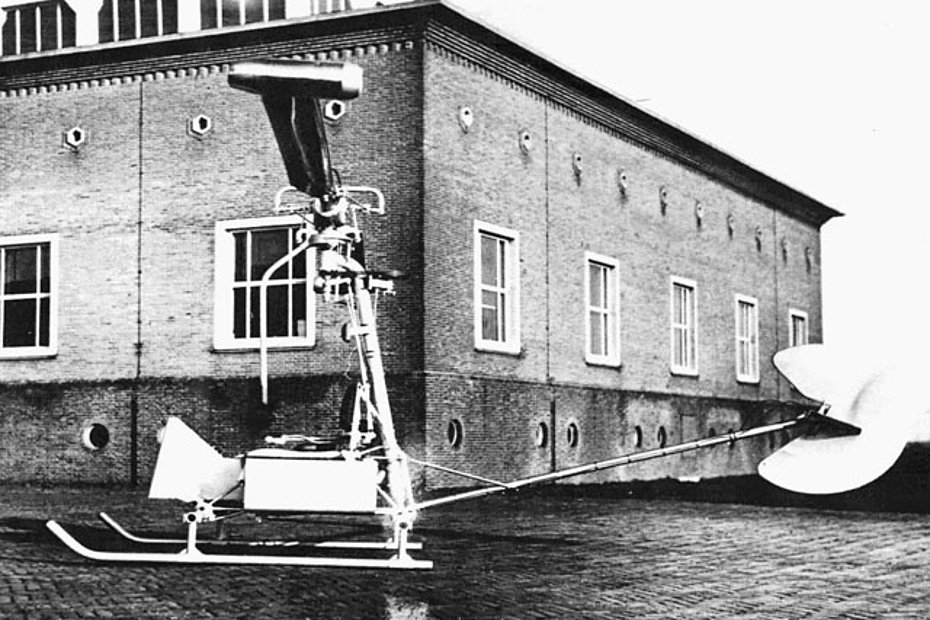
The first civil helicopter manufactured in series powered by ramjets
The article about the N.H.I. H-3 Kolibrie is largely based on historical information contained in an account sent to the author by Will Albert Kuipers (1920-2007), an engineer of Dutch origins delighted that a helicopter enthusiast like me continued, after many years, to be deeply interested in the small aircraft he worked on after graduating from the university of Delft. At that time (we are in the early 1950s) Kuipers focused his interest on the aviation world. At that time (we are in the early 1950s) Kuipers joined a small team of engineers led by Gerard Frans Verhage and Jan Meijer Drees who were working on the development of an experimental helicopter.
After participating in the development of the N.H.I. Kolibrie he moved with his family to the United States in 1961, where he continued his aviation career working on behalf of Bell Helicopter and participating, among other things, in the development of the rotor of the famous Bell AH-1 Cobra.
The story of the Kolibrie is interesting because it allows the reader to understand how many and what kind of difficulties can affect the success or failure of an innovative project such as the Dutch two-seater.
Origins and development
In May 1940 Netherlands fought bravely against the armed forces of the Third Reich after the latter, violating their neutrality, invaded them following the principles of the so-called blitzkrieg. The crews of the modest Dutch air force fought to the last. Many of them joined underground movements after the defeat to continue the fight. One of these men was Gerard Frans Verhage (1912-1968), a Netherland Postal and Telephone Services (Staatsbedrijf der Posterijen, Telegrafie en Telefonie - PTT) engineer peacetime, who was an observer on the T-5 twin-engine bomber in service with the Royal Netherlands Air Force shot down in combat over the Dutch polders. During WW2 he helped to maintain wireless contacts with the Allies. In addition to this he bridged the five years of Nazis occupation with studies. Helicopters had always been his hobby, and the problem connected with autorotation keenly interested his mechanical mind. It was hard for him to believe that, after an engine failure, a helicopter pilot had to react within a second to change the collective blade-pitch into autorotation, with a (fatal) crash as the only alternative. With professor Heinrich Focke’s standard work on rotorcraft as his only source of information Verhage started to design a new type of rotor construction which would offer greater security. The result was a mechanism incorporated in the rotor hub that might take care of a pitch reduction automatically in case of engine failure. The design he finally hit upon was a simple arrangement of retention parts that sensed the rotor speed and modified the pitch accordingly. In 1948 a national engineering periodical published a report on his “self adjusting rotor blade” for which a patent had already been taken out. When Verhage approached his superiors with this idea they suggested that he have the feasibility of it evaluated by Nationale Luchytvaart Laboratorium N.L.L. (National Aeronautical Research Institute), an independent non-profit foundation providing technological support to the aerospace industry known by 1961 as Koninklijk Nederlands Lucht- en Ruimtevaartcentrum N.R.L - National Aerospace Laboratory (nowadays it is known as Royal Netherlands Aerospace Centre. It is important to remember that already at the beginning of 1946, the Dutch government became interested in the helicopter’s potentials. For this reason a delegation travelled to the United States where the first helicopters for military use were put into service. It quickly became clear that helicopters had unique flight characteristics that made them particularly suitable for both military and civil uses. After the establishment of a study group the “Stichting Hefroefvliegtuigen” (Helicopter foundation) headed by Mr. T. van Houwelingen, former general director of the PTT was founded in 1947. Among the members of the foundation were some large companies such as KLM, Frits Diepen N.V, Fokker, PTT (its representative was Gerard F. Verhage), the Dutch Institute for Aeronautical Development, the Ministries of Agriculture, Traffic and Water Management, War and the Navy, and the Dutch Railways. The Foundation employed a part of the funds to purchase a Sikorsky S-51 (PH-HAA) originally imported in Holland by Frederik Jan Leo (Frits) Diepen (1915-1974), a Dutch aviation pioneer and industrialist best known for being the founder of Avio-Diepen. He was one of the key people of the reconstruction of the Dutch aviation industry after World War II. The Dutch Navy provided pilots and technicians who followed a training course in the United States. After their return to Holland they performed different tests, to assess the feasibility of operational use for each of the foundation members.
A fortuitous encounter
Using the facilities of the PTT research laboratories a model was built by PTT technicians mostly after regular working hours. When it was finished it was taken to Amsterdam for testing at the N.L.L. In that period Jan Meijer Drees (1923-1999), a brilliant aeronautical engineer whose interest was primarily in aerodynamics was attracted by Verhage’s model. Drees completed his studies in extraordinary rapid fashion and graduated cum laude in 1948 a year ahead scheduled. He then went immediately to work on behalf of N.L.L. as a flight engineer. This is how Gerard Verhage and Jan Meijer Drees met and then became friends. A long series of meetings and discussions followed during which many aspects of helicopter design and Verhage’s idea in particular were analysed and discussed. The model performed exactly as expected and showed so much promising that the idea germinated to evaluate it full scale. In Spring 1950 Will A. Kuiper graduated from Delfit on a project concerning rotor and transmission design and started to work on behalf of the Netherland Navy which set up and evaluation team charged to evaluate a suitable helicopter for its services. In that period Dick Swart (a designer just out of school) and Dick Biekart also started to work on the project.
The small team decided to build a full-size helicopter test bed to evaluate Verghage’s rotor system. Pre-design studies were made and they crystallized into a simple one-man helicopter with a truss-type fuselage out of welded steel tubing powered by a 30/40 kW/hp lightplane engine. The transmission was an adaptation of an automotive rear-axle and differential. The rotor was a simple two-bladed rotor incorporating Verhage’s retention system. The whole design was somewhat inspired by several experimental one-man helicopters that were being built at the same time by various individuals and manufacturers in the USA.
In June 1951 Will and Jan attended the XIX Salon International de l’Aéronautique in Paris. In that occasion they understood that there was a strong interest in the use of the helicopter in agriculture. Also the idea of rotor tip propulsion catched the general aeronautical industry’s attention. The two young engineers’ attention was captured by the SO 1120 Ariel III helicopter powered by a turbine. On this model compressed air was led out the rotor blades.
The important role of the Helicopter foundation
The flight experience gathered by the Helicopter foundation with the Sikorsky S-51 led to a new important decision. Mr. van Houwelingen and professor van der Maas in his function as head of the Netherlands aircraft development board - N.I.V.) were both aware of the efforts made by Verhage and his team, and were the opinion that a part of the founds of the foundation could be used for the helicopter development. The official decision for rededication other funds to the new purpose was made at a meeting held at Schiphol airport. At this point (1952) the Helicopter foundation was dissolved and a new organization was formed under the name “Stichting voor Ontwikkeling en Bouw van een Experimenteel Hefschroefvliegtuig – S.O.B.E.H”, or Foundation for Development and Building of an Experimental Helicopter.
Power plant decision
After the Salon International de l’Aéronautique in Paris the small team of S.O.B.E.H. guided by Jan Meijer Drees took an important decision: Jan convinced the other members to develop a new helicopter powered by ramjets.
Ramjets are the simplest airbreathing means of propulsion but they have a higher fuel consumption. The principle of ramjet operation is very simple. The main parts of this power unit are: air intake, flame holders, fuel nozzles, ignition, combustion chamber and exhaust. The air is slowed down by the air intake and in the diffusor. Accordingly its pressure rises with nearly the dynamic pressure, belonging to the tipspeed. It then passes the flame holders and enters into the combustion chamber. Here a large temperature rise occurs, which causes the gases to expand, thus leading to a high exhaust velocity. The change in momentum corresponds to the gross thrust. The net thrust is smaller, because of the cold drag of the engine. To the outset it was decided to base the ramjet design on the use of kerosene. In Holland this fuel was popular from home heating and also, it was the fuel which was in widespread use for the engines of inland barges. It was to be expected that its cost and taxation would always be low, as the extensive barge traffic depended upon this. An additional advantage was that this fuel had a low vapor pressure and was difficult to ignite, an important factor in terms of flight safety. To see if this fuel was feasible to be used a simple test stand was set up in the N.L.L.’s buildings. The team was immediately confronted with ignition problems, however thanks to the invention of another Dutch engineer development progressed. The first ramjet known as the TJ-1 manufactured in the course of 1952 by Kromhout Motoren Fabrik in Amsterdam (builder of engines for shipboard, barge or stationary uses) was a simple tube of thin stainless steel sheet material with a round cross-section. In front of this there was an air inlet, machined out of aluminium. It had an inner and outer part, which fit together. The aft end of the stainless steel tube had a contraction for the exhaust. A lug was welded on the side of the attachment to the blade or the whirling arm of the test stand. Flame-holder and igniter location were as determined on the static test stand. In a relatively short time modifications were made turning the TJ-1 into the TJ-2 (1952-1953), with a much shorter combustion chamber and a new tailpipe made of a simple cone of sheet metal. More experimentation followed and the new findings were incorporated in the new TJ-3 completed in 1953 whose attachment to the rotor blade was modified.
New problems caused by cracks and deformations in the ramjets appeared. It was therefore necessary to redesign them and improve the power output which was not enough on the TJ-3.
These improvements led then to the development of the new TJ-4 which had double ramjet size and was less sensitive to flame out. Another novelty was the introduction of stabilizers fins welded on the external part of the ramjets.
Construction of the first prototype
At the same time the group started the construction of the first prototype known as the S.O.B.E.H. H-1. For its construction the team decided to move to a remote location called Nederhorst den Berg. There the PTT operated an experimental radio antenna laboratory known as NERA (Nederhorst den Berg/Radio). As already said an important contribution to the development of the project came from the people employed by PTT who worked enthusiastically on the project.
The H-1 had a fuselage consisting of a welded truss frame, out of steel tubing, with a central fuel tank and two side-mounted tanks. The two-blade see-saw rotor and shaft were mounted on a pylon formed by a large diameter aluminium tube, sticking up from behind the seat, which itself was on top of the central tank. The tailboom was an aluminium tube also carrying a rudder surface operated by pedals. The rudder was attached by a universal joint so the hinge line could be positioned perpendicular to the airflow.
As written by Will A. Kuipers much of the H-1 design was derived from the Hiller Hornet HJ-2, which looked like a logical, straightforward design approach for the Dutch team. The rotor blades were manufactured by Fokker which had the capability and the quality control required.
In April 1954 when the construction of the prototype was completed the flight test program started. The first flights were performed by Lt. Cdr. Rudolf (Rudy) J. Idzerda, a Navy’s helicopter pilot who was among the first Dutch helicopter pilots to be trained in the USA in 1947 with the financial help of the aforementioned Helicopter foundation.
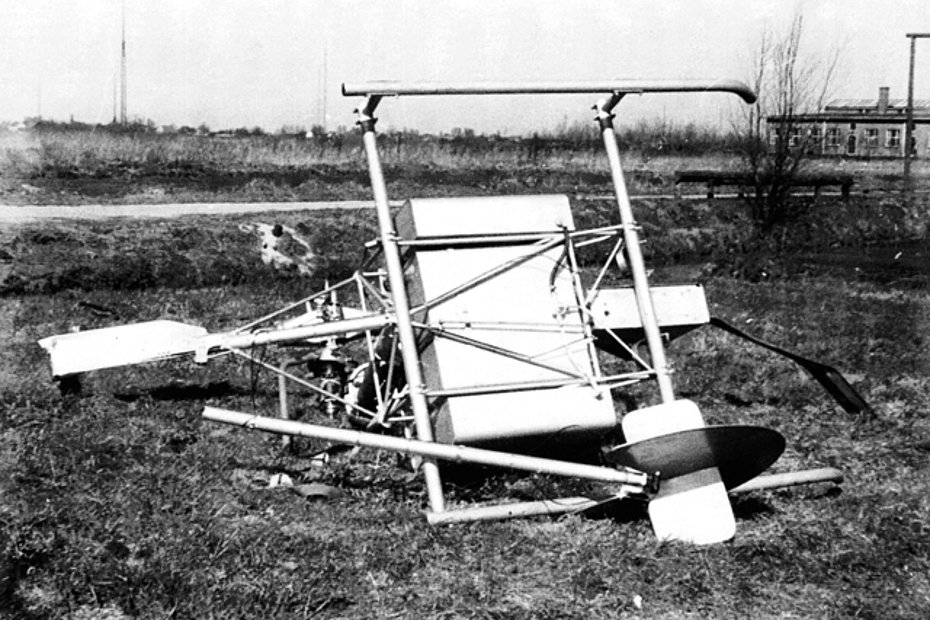
During one of the test flights a flame-out occurred forcing the pilot to execute and emergency landing during which the helicopter rolled over. Luckily the test pilot was only slightly hurt. The helicopter instead was seriously damaged.
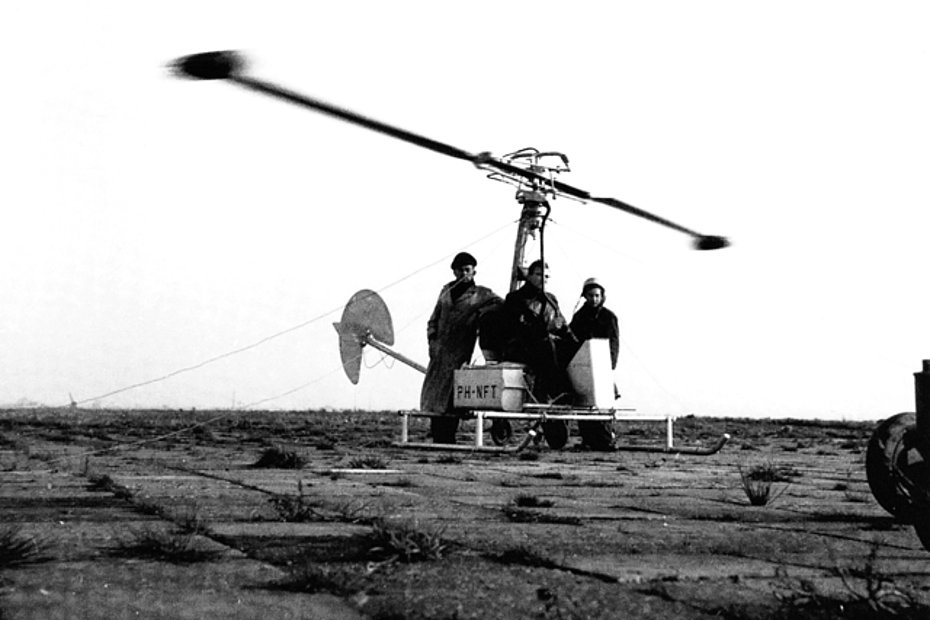
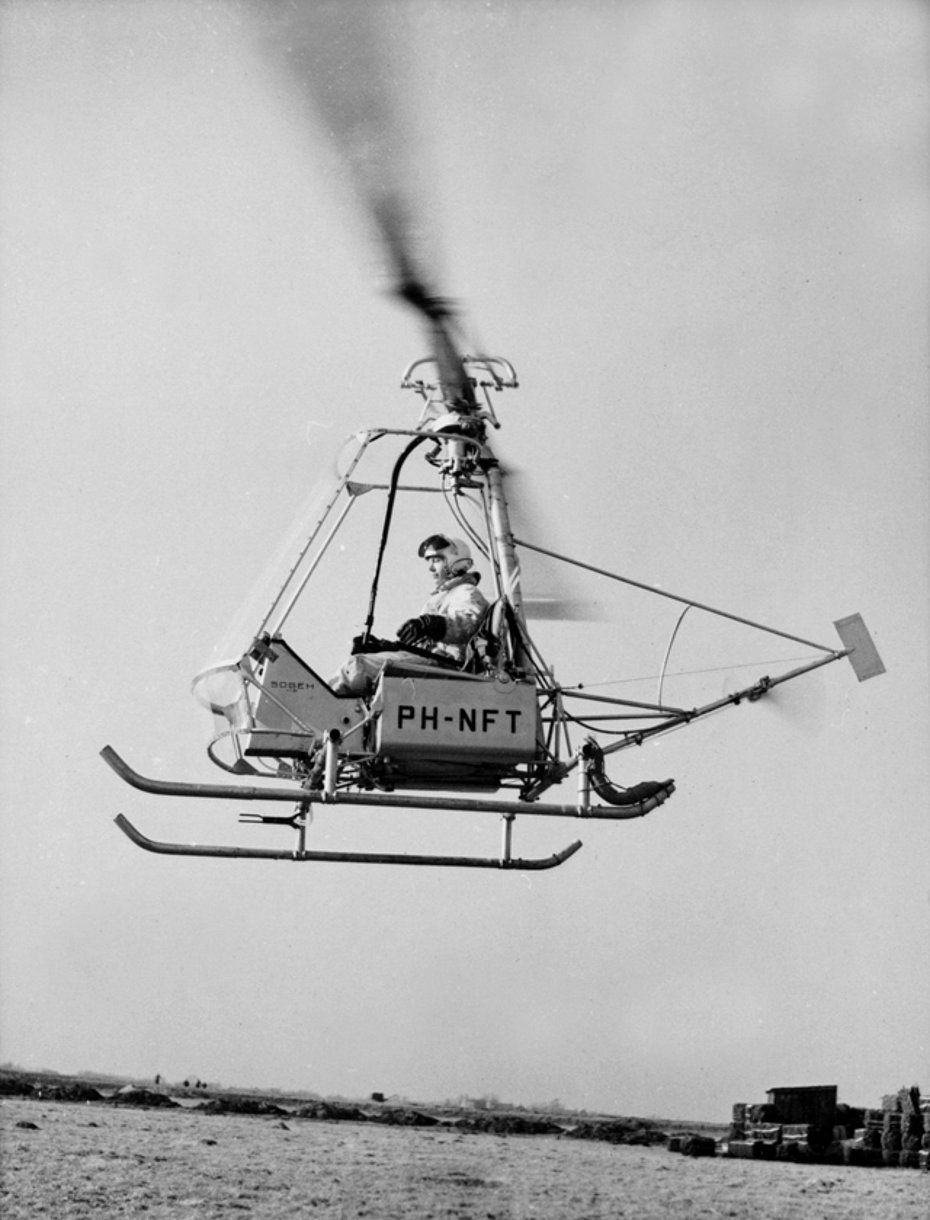
Fuel distribution was a problem on this model, therefore the prototype underwent a series of modifications.
Second prototype
After the accident the team moved close to Rotterdam where two prefabricated buildings were rented. One was used by the engineers while the other was used as workshop. The whole was situated in the Northwest corner of the future Zestienhoven airport (the construction of the airport – nowadays known as Rotterdam The Hague Airport - began in August 1955 and it was officially opened in October 1956).
It was there that the second prototype designated H-2 was built. Of the original design of the H-1 the team retained the main rotor blades, the rotor drive shaft and mast, the steel tube fuselage frame with tanks and the landing gear. The long tubular tail and the universally movable rudder surface were also initially kept. Unlike the H-1, the H-2 could carry a passenger seated next to the pilot.
The main rotor hub and the engine were completely redesigned and the original control system was adapted to the new hub.
With this configuration control was much improved. The rotor diameter was augmented and counter weights added.
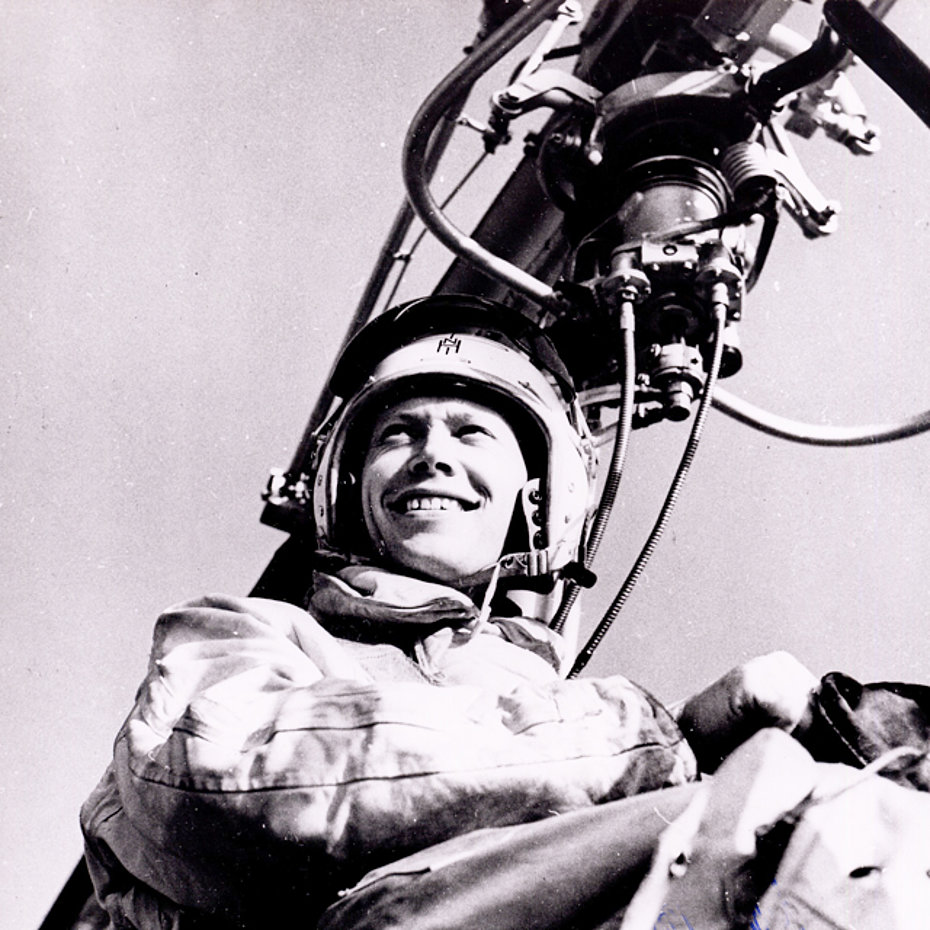
New engines and new test pilot
The part-time activities of the two test pilots Idzerda and Greve were helpful but what the team now needed was someone who was fulltime available. For these reason Reiner Joseph "René" van der Harten, a veteran Navy helicopter pilot on loan from KLM joined the group. Because of the way he took charge of flight test development he became a powerful force toward success of the whole undertaking. René made his first flight at the controls of the H-2 on November 9, 1955.
During the hovering manoeuvres close to the ground it became increasingly clear that the directional control on the H-2 was insufficient. Reluctantly the engineers decided to install a small single blade tail rotor made of balsa and spruce controlled by two pedals like on conventional helicopters. To increase the safety of the people assisting the tests the tail rotor was protected with a ring-shaped guard. To provide some directional stability with the now much shortened tail and inverted V shaped surface was mounted at the end of the tailboom, aft of the tail rotor.
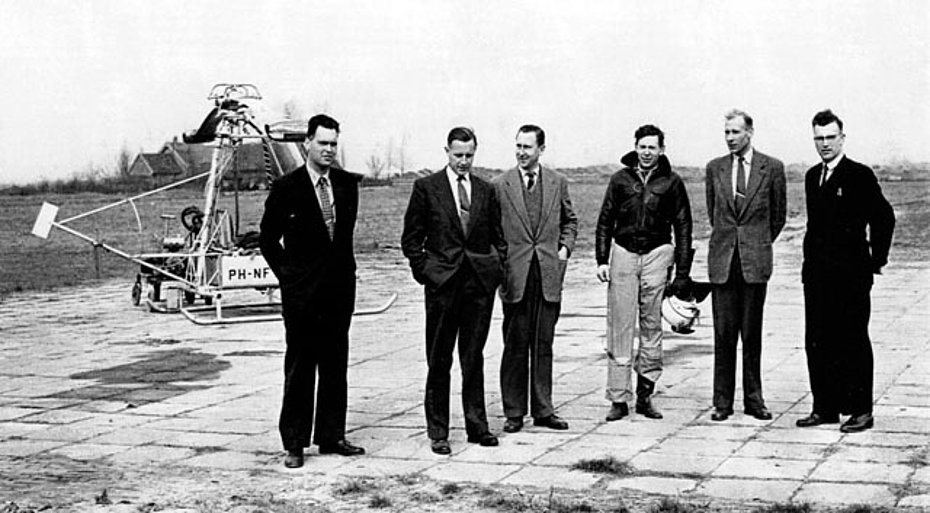
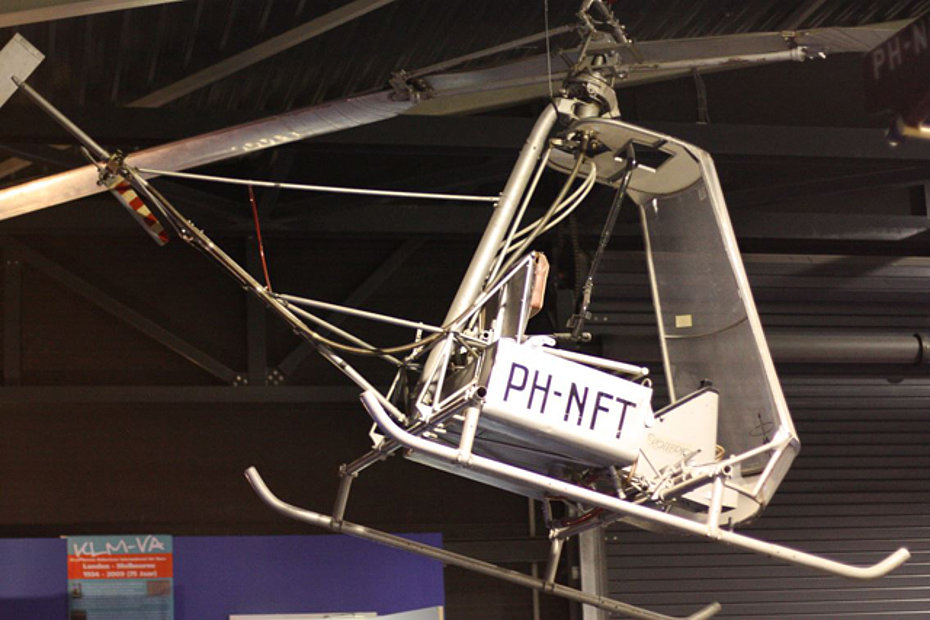
In this period a new whirling arm was built. Protection was provided by a ring of pre-cast concrete L-shaped pieces placed at right angles to tangent lines from the tip of the arm in a circle. Air could circulate through the ring so there was little or no exhaust and heat contamination of the inlet air. A small shack just outside the circle of platforms pieces housed the controls.
At René’s suggestion the helicopter was converted into a two-place by moving the pedals to the right side of the instrument panels and moving the collective pitch lever to the centre of the bench seat. During the winter 1955-56 all modifications were completed and the prototype was ready for a new series of test-flights powered by the brand new TJ-5 first tested in the course of 1955 which retained the fin now directly attached to the blade attachment.
Confidence was quickly gained in the response of the machine and the point was reached where the helicopter was actually flying instead of just making “short hops”. Rapid progresses were made. Among them there was the first flight with a passenger: Gerard Verhage was offered the privilege of being the first passenger.
As it happens with all the prototypes the H-2 also underwent a series of modifications. The seats which started out as angular weldments out of steel tubing, developed into comfortable assemblies out of aluminium sheet metal and tubing and were supplied with durable fixed upholstery. The tail boom was stiffened and instead of a single brace to the fuselage was braced to the landing gear cross tube. The fin surface at the end of the boom was enlarged, the hanging control stick underwent a transformation as did the control panel, the pedestal and the windshield.
With all the modification and the new engines the H-2 (nowadays on display at the Aviodrome in Lelystad) turned into the H-3, a flying machine that was to be used for a long time until well into the time H-3 models manufactured in series were available.
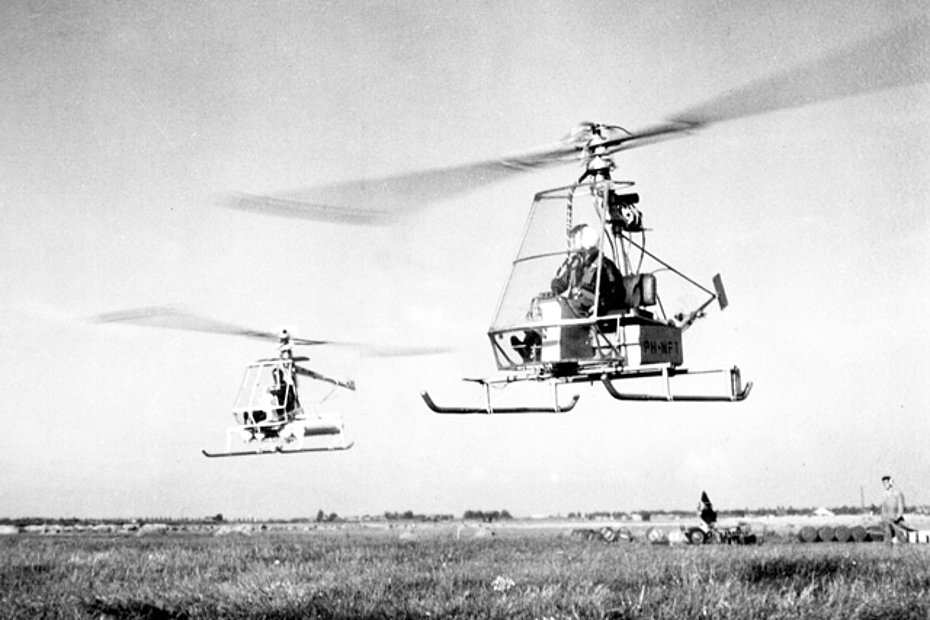
One of these modification was a device suggested by Jan, a vibration suppression mechanism intended to reduce the two-per-revolution vibrations in the hanging control stick. The so-called “Frahm” damper had a suspended weight on a steel rod from the handgrip. It was tuned right at two-per-revolution so anytime the stick vibrated at that same frequency the vibration was absorbed by the motion of the weight leaving the handgrip relatively smooth. Later the H-3 handgrip design was improved with a bell shaped housing at the bottom. This housing contained the weight with only limited freedom all-around. The housing prevented the oscillations from becoming so large as to cause fatigue damage. Rene was enthusiastic about this shape, as it permitted him to rest his hand on it, which was helpful in reducing fatigue of another kind, namely in the arm. Commonly one of the objections to hanging or overhead control stick had always been that it was impossible to rest the elbow on the knee, like with a control stick coming up from the floor.
The hanging cyclic stick had a tendency to move back toward the pilot because his own weight and therefore a small overcentering spring was mounted at the upper end to offset this. By doing this it was possible to adjust the location of one of the ends of the spring and have the stick where wanted. This functioned as an adjustable trim.
Another improvement was the starting system first introduced on the H-2. It consisted of a converted Puch (or JLO) moped engine mounted high behind the rotor pylon. The disadvantage of the extra weight was offset by the convenience of being able to start up the rotor everywhere without being dependent on ground starting equipment. The original starting gearbox motor however interfered with the passenger’s seat and therefore it was modified.
A considerable improvement on the H-3 was the completely separated fuel system for each ramjet. These changes and the improvements augmented the empty weight at the expense of the payload. Therefore to counteract this, every suggestion for weight saving was considered.
Nederlandse Helikopter Industrie - N.H.I. is launched
Until that moment the Dutch group was officially organized as a non-profit organisation. The funds for the development from the original “Helicopter foundation” had been depleted and the team was operating in effect on research grants from Netherlands aircraft development board - N.I.V.
With the possibility of turning this research and development project into a marketable article becoming more real, the time had come to change the organisation into an industrial company. The charter of the N.I.V. permitted research grants, but it didn’t include financing for this. N.I.V. representing the government, was willing to become a minority partner, but efforts had to be made to find at least two other financial partners. One of these was easily found: Kromhout Motoren Fabriek (KMF) builder of the ramjets.
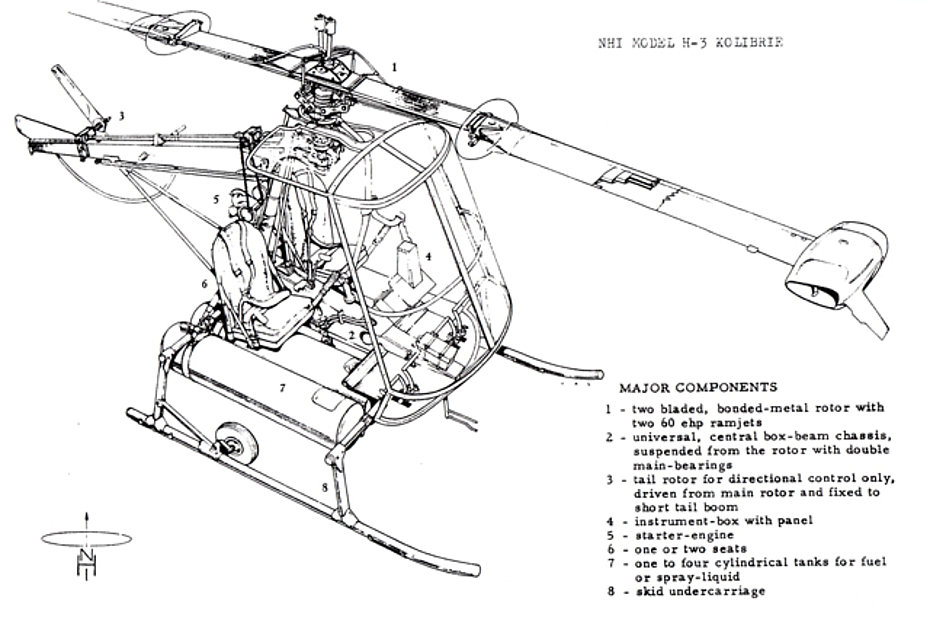
Fokker with the valuable experience gained by building the rotor blades declined to take part.
Aviolanda, a family owned company like KMF, involved in aircraft repair and overhaul was seeking to diversify its activities and also became a partner.
On December 7, 1955 Nederlandse Helikopter Industrie (N.H.I.) was launched and a new capitol of the story began. The company was structured like a regular corporation. Development costs were separated between development and certification, cost of production, marketing, demonstration, etc. The administration became more complex and time card were introduced. About 45 people were now employed, almost half of them for administration to meet the requirements of N.I.V.’s government regulations. Overhear costs soared. Gerard Verhage at that point took the decision to leave his employ at the PTT to became the director.
It is a farly well known rule of thumb in the helicopter industry that it takes about as much money and effort to roll out a brand new prototype as it takes to develop it in flight test and to obtain its airworthiness certificate. This proved also true for the Kolibrie. Nobody however was really prepared for the difficulties of setting up a worldwide marketing and support program, but this was right what it was necessary to do.
In the meantime newly hired auditors and technical personnel from the N.I.V. visited the engineers frequently. They wrote critical and often damaging reports of which the group was not made aware until it was too late to point out inaccuracies.
As a result professor van der Maas grew increasingly sceptical. A first indication of this change of attitude became evident when he called on independent experts from England for advice on professor van der Neut to develop another ramjet design. All that took place in a very inopportune time. The engineers were in the middle of the endurance test program in preparation of the certification of the ramjets. It caused quite a stir in the engine group. The head of this group was so upset about this that he resigned immediately after he completed the certification of the world’s first ramjet for use on a commercial helicopter.
N.H.I.’s shareholders involved in the financing of production and marketing also started to get nervous, insisting that it was necessary a handsome profit on the first production batch of 10 aircraft under construction while the certification program was still in progress. That turned out to be an impossible task in view of all modification it was necessary to incorporate in the productions aircraft and because of the initial technical difficulties that the engineers were facing in the field and the contracting troubles the group was experiencing.
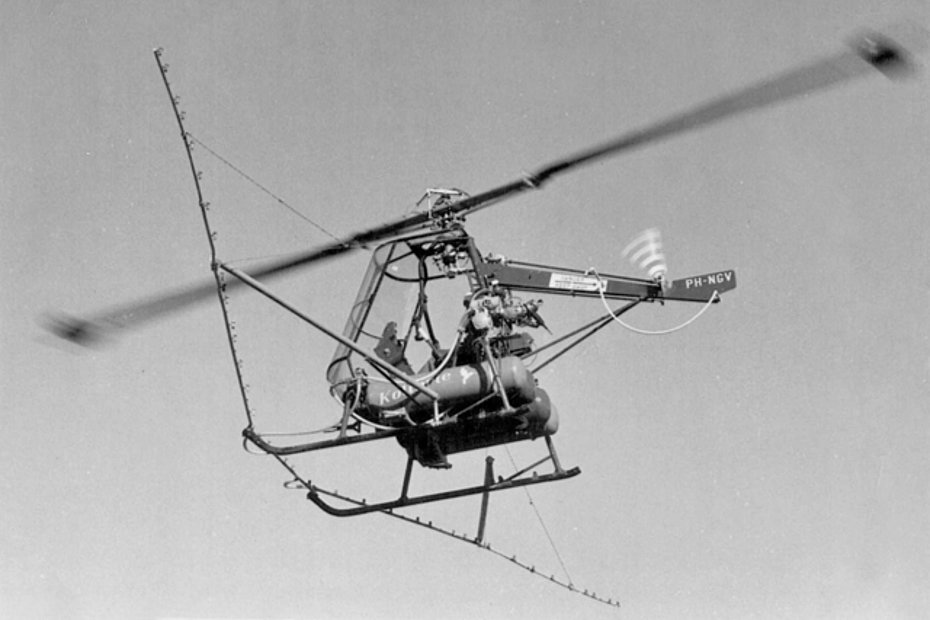
It became clear that the original strong support enjoyed for years by the “original team” was quickly eroding away just when it was needed the most. Early in 1958 the crisis intensified considerably. The small technical staff became overburdened with all the start-up and field problems, foreign certifications, demonstrations for potential customers, altitude tests, etc. Signs appeared of funding troubles as indicated by delays in payments to suppliers. Soon however both Gerard and Jan who needed all the energies to stay on top of all these developments became serious distracted by actions taken by the board of directors and by N.I.V. in particular.
Suddenly Verhage was asked to resign. He was among other things (according to some unjustly) accused of mishandling a detail concerning subcontracting the fabrication of the landing platform/trailer designed by the engineers to ferry the helicopter from job to job along the road.
That alone certainly could not be the reason for such drastic action. Was there a serious personality conflict between Verhage and van der Maas? Probably but Jan Meijer Drees was convinced that Gerard was made the scapegoat for many new obstacles the group had to overcome by leaving its sheltered life of technical development and facing the real world of competition and stiff customer demands.
To make matters worse out of the blue sky and without any prior discussion it was told to stop all activities and to let go the entire engine group. The N.L.L. which had a research institute had very little impact on development was assigned to take over that work.
Early in 1956, the production of an initial series of five Kolibries started, followed by a second batch of five.
The first H-3 with call sign PH-NHI (s/n 3001) made its maiden flight on May 29, 1956 piloted by René van der Harten and was retained for flight test work. At the same time the company moved to a new location in the industrial area along the main entrance of the new airport of Zestienhoven.
Certification program
As Netherlands did not had government imposed qualification criteria for helicopters, it was decided by R.L.D. (Rijksluchtvaardienst the equivalent of the US Federal Aviation Administration) along with the team to base certification on the United States Civil Airworthiness Requirements for Rotorcraft of this weight class category.
Supplying the required data for airworthiness certification brought about a prodigious amount of work, too much for the small group to handle. In the program there were included tests on the whole helicopter and static fatigue tests on components.
N.L.L. signed a contract with N.I.V. to perform the flight measurements and develop a data recording package that could be installed on the helicopter, a huge work. It also meant providing a complete set of drawings and stress reports on all major components all on one frozen configuration. As the team was continuously doing improvements it was an additional load to keep the certification model up-to-date.
As obtaining certification would mean delivery of helicopters to customers, it was also necessary to supply a complete parts list, maintenance manual and flight manual.
Ramjets or toilets?
In spite of the progress made relations between the technicians and the N.I.V. did not improve after the formation of the company. Also relations between N.I.V. and the two shareholding companies were not very good. There was an understable concern on the part of the two companies, that their investments was being used for development purposes, while, on the other hand N.I.V. was concerned that government founds intended for research and development were in fact spent for production and promotion of a marketable helicopter.
Continuous flight tests revealed new problems with the cracks in the body shell of the ramjets.
N.I.V. was conveinced that Verhage’s team was not capable to handle the problem and that external help was needed. They found this expert in the form of a British company engaged in the manufacture of stainless steel aircraft toilets.
When the team was confronted with this outragius example of well-intentioned but insulting and useless help by people who had not inkling or understanding of the real problems, the team was flabbergasted.
The problem was not with material or with the way the ramjet was manufactured. On the contrary both type of material and the welding technique were considerably more sophisticated than was called for in the manufacture of aircraft toilets a fact which was soon clear to the “consultants” to their embarrassment.
The solution was to tie top and bottom together, with a strut that would naturally have to be fuel cooled as it was positioned in the middle of the combustion chamber. This was the last major modification to the ramjet. Except for later changes to the stabilizer fin, this was the configuration that was to perform for many hundreds of hours without problems.
To note that during the ramjet tests in a special whirl rig the centrifugal the assembly reached a centrifugal load of 1,880 g’s without other problems than deformation in the shell. This load would be experienced at an overspeed of the rotor of more than 150%.
Development of equipment
While works were underway on the first production helicopters a series of optional equipments were developed. The first was a spray rig for agricultural applications of liquid fertilizers and pesticides tested on the H-2 model. At least two models of spray equipment were developed. To help shorten turn-around times at the end of each turn to increase the power of the tail rotor its diameter was again enlarged.
A special test instrumentation container was installed on PH-NHI for flight test measurements. At N.L.L. fatigue tests were running on the main hub element of the rotor which proved to be very successfully designed.
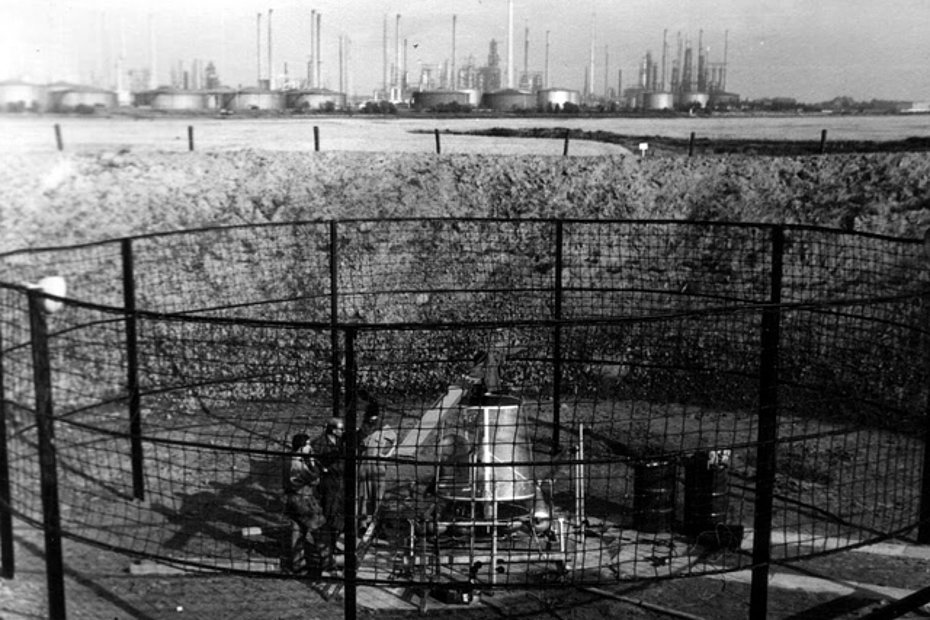
During the 500 hours endurance test one of the helicopters was completely destroyed and the youg mechanic Schreiner was seriously injured. Despite frequent inspections of the ramjets the team failed to spot the start of a fatigue crack in the attachment lug or the crack started and progressed too rapidly to be spotted. The ramjet came off causing the subsequent destruction of the helicopter. Unfortunately one of the rotor blades hit the man’s leg. Unfortunately due to complications the man lost his lower leg.
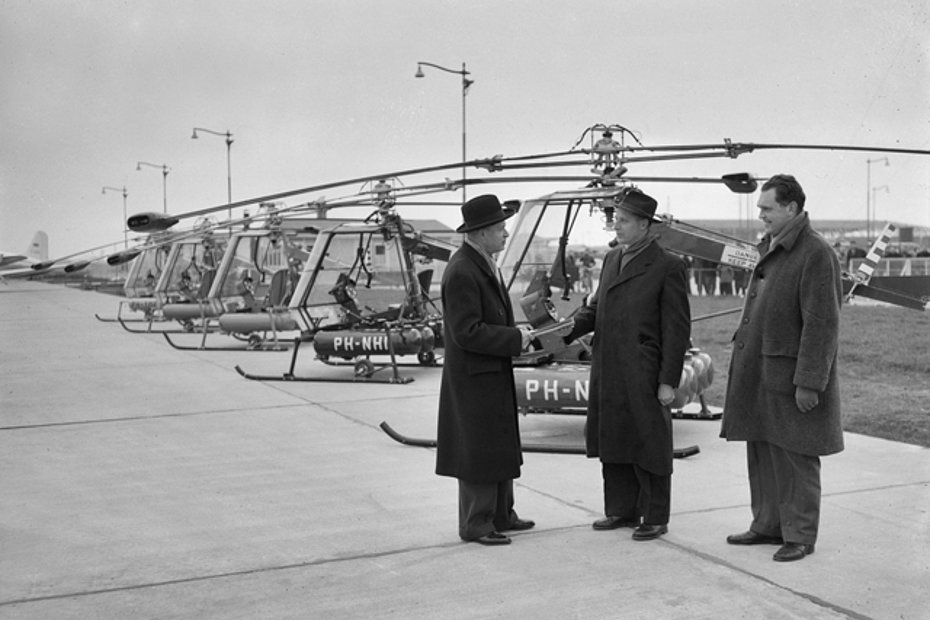
The decision was made by N.I.V. to build up a new endurance stand and repeat the test in Botlek at the end of December 1958 where the helicopter was controlled from a remote protected location for safety.
Type certificate issued
On March 3, 1958 after 500 hours endurance test, two and a half years of flight testing and 150 hours engine test the long awaited certificate of airworthiness was granted in an official ceremony at Zestienhoven airport.
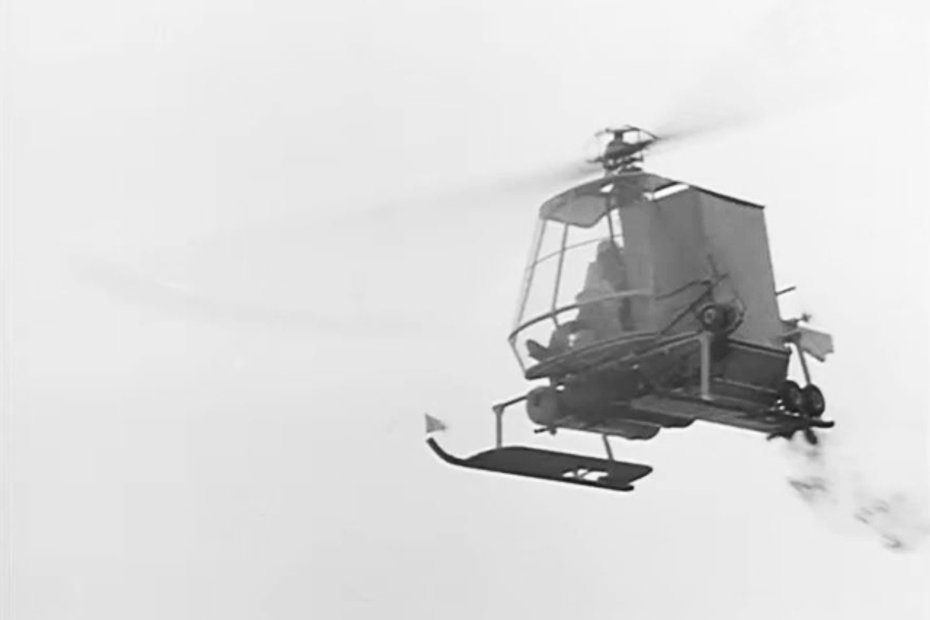
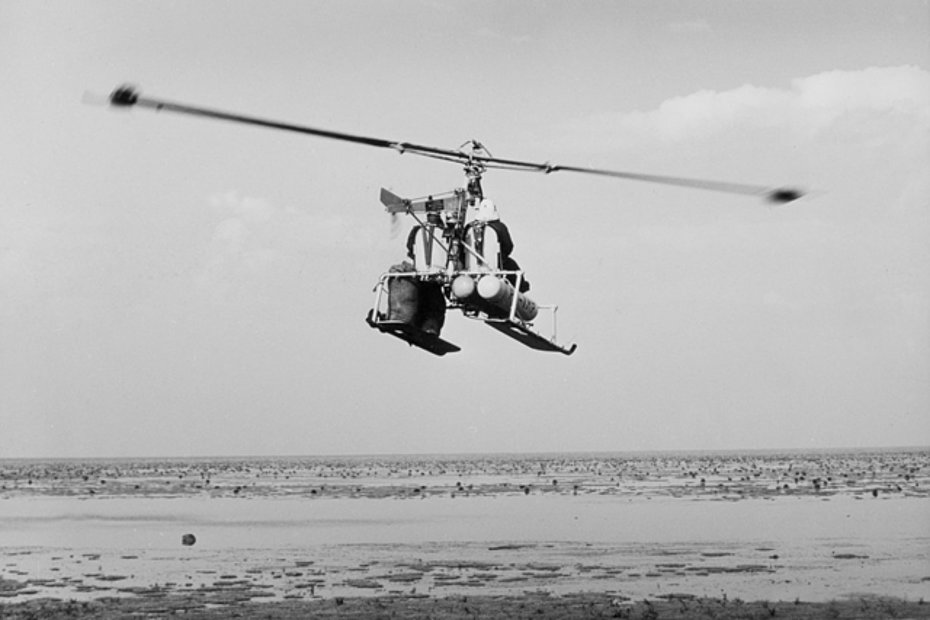
In that same occasion Jerry Renov who saw the Kolibrie (PH-NHI) for the first time during the exposition in Utrech on June 10, 1957 announced his intention of purchasing three Kolibries for his company “Wings of Israel” (accordinghly to the information gathered , in 1960 the selling price was about $22,500, corresponding to about 181,000 CHF at that period).
Jerry Renov was a young American pilot when he arrived in Israel in 1948 to help create the Israeli Air Force. He then help members of a Kibbutz in the north of Israel. In the coming years Jerry Renov used his Kolibries to sow seeds of corn, sunflower, etc.
That day marked indubitably a milestone in the development of the Dutch helicopter.
With the issue of the certificate of airworthiness the Kolibrie could now be employed for commercial operation.
The very first operational experience took place when PH-YMP (s/n 3006) was extensively used on behalf of the Directorate Wieringermeer, an official Dutch body which was in charge of a large scale project to gain new land from the former Zuyderzee.
The Kolibrie was immediately put to work to destroy coltsfoot, a weed which was endangering the newly-won land, and to sow reed in the recently formed Eastern Flevoland polder (reed improves the initial quality of the former sea-bed while later it can be made to disappear simply by lowering the ground water level).
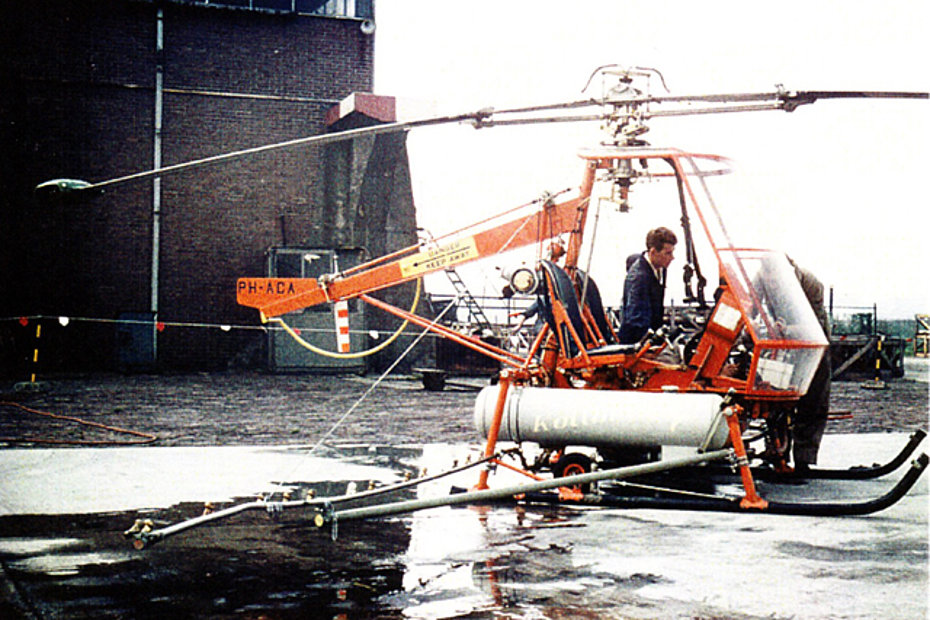
In two months of operations, from the middle of March to mid-May, the Kolibrie flown by Robert A. S. de Blécourt (who started his activity as a test pilot in that period) logged 120 flying hours. The daily average worked out at 3-4 hours but under favourable conditions daily rates of up to nine hours were recorded.
In the weed-killing operation 12 sq km (3,000 acres) were sprayed in 40 flying hours while a total of 161 sq km (40,000 acres) of polder land was sown with red seed in 80 flying hours.
Maximum flight times up to 9 hours per day were made. Every sortie took about 20-30 minutes.
Its employ evidenced some handicap such as the short range, while the reed seeder developed by the team clogged up during the aerial application.
In November 1958 van der Harten trained the pilot J. Latooy from Velsen to continue the sowing work with the PH-YMP. Thousands of jute sacks filled with soft reed seeds were spread on the polder.
Another helicopter was loaned to the light aircraft department of the Dutch Air Force for evaluation.
Difficulties almost immediately developed with contracts while inaccurate sales brochures caused a sale to fall through. The company had also their technical share of troubles: on the field experiences showed new mechanical troubles that were not encountered during the 1,000 hours endurance test. The frequent and sharp manoeuvring, the rough handling on the ground, and the influence of dirt and chemicals apparently gave rise to other loads and circumstances then simulated by the test program. It was for instance found that ground handling load on the tailboom construction were much higher than ever anticipated in the design. Another typical example is the nylon bearing in the middle of the tailboom that was needed to pass a natural shaft frequency. The shaft fits loosely in the bearing. While spraying a copper emulsion, the copper particles penetrated the bearing that became overheated. Of course full advantage was taken from the experience during the first operational period and modifications eliminated the teething troubles encountered during the first employs.
German manufacturer Dornier was seriously interested in the Kolibrie and proposed to organize the partecipation of the Dutch team in the Hannover messe a well known international trade fair. Dornier also wanted to enter into a licensing agreement and proposed to organize spraying demonstrations throughout the Federal Republic. Through Dornier’s effort certification proceedings were started in Western Germany.
Despite the basis of certification was the US Civil Airworthiness regulation the H-3 Kolibrie never obtained the US type certificate. Among the reasons was that the Paris bureau was still dependent on decisions from Washington. This situation caused the procedure to be of much longer duration and therefore was never completed. In all probability this situation would have been considerably different if the Dutch team had an agreement with a US company to either import or distribute the Kolibrie, or build it under licence in the USA.
In July 1958 while been used for spray operation in West Germany PH-ACC was seriusly damaged after a forced landing in trees. The pilot luckily was not hurt but the accident (caused by strong vibrations) set the German certification procedure back.
Two years and many hundreds of flight hours later Rene van der Harten experienced a similar problem when the helicopter and spray boom got into a violent vibration severe enough to force the pilot to quickly land.
The Dutch government generously underwrote the development of the Kolibrie but didn’t find it useful.
In fact in July 1958, despite the enthusiastic reports, the Air Force announced that the helicopter was not suited for military use. Short range and high fuel consuption were the main reasons. Overhead cyclic stick was another reason because military pilots preferred to use a control stick coming up from the floor (for this reason in 1960 the demonstrator PH-NGV was experimentally modified with conventional controls).
Up and downs
On September 8, 1958 Gerard Verhage and Jan Meijer Drees took everyone by surprise by announcing their resignation from the company. Several weeks of negotiations and attemps to save the situation failed. Gerard was offered to return to PTT while Jan in January 1959 emigrated with his family to the US where he was offered a position with Bell Helicopter Company in Fort Worth/Texas.
According to the accounts of Will A. Kuipers differences of opinion between the management and the stockholders had reached a point where it was impossible to continue, but there were probably others reasons.
The management of the company was put in the hands of a new manager with engineering training but not experience in aircraft engineering.
Work continued and some results started to come in. A British company named “British Helicopters Ltd” based at Ipswich placed an order for a Kolibrie to be used in agricolture. At the end of the year the British civil airworthiness authority granted a certificate of equivalency meaning that they acknowledged the validity of the Dutch certificate of airworthiness. The British operator purchased PH-ACD (s/n 3009) which then became G-APRZ. This was an important achievement because it increased the marketing potential.
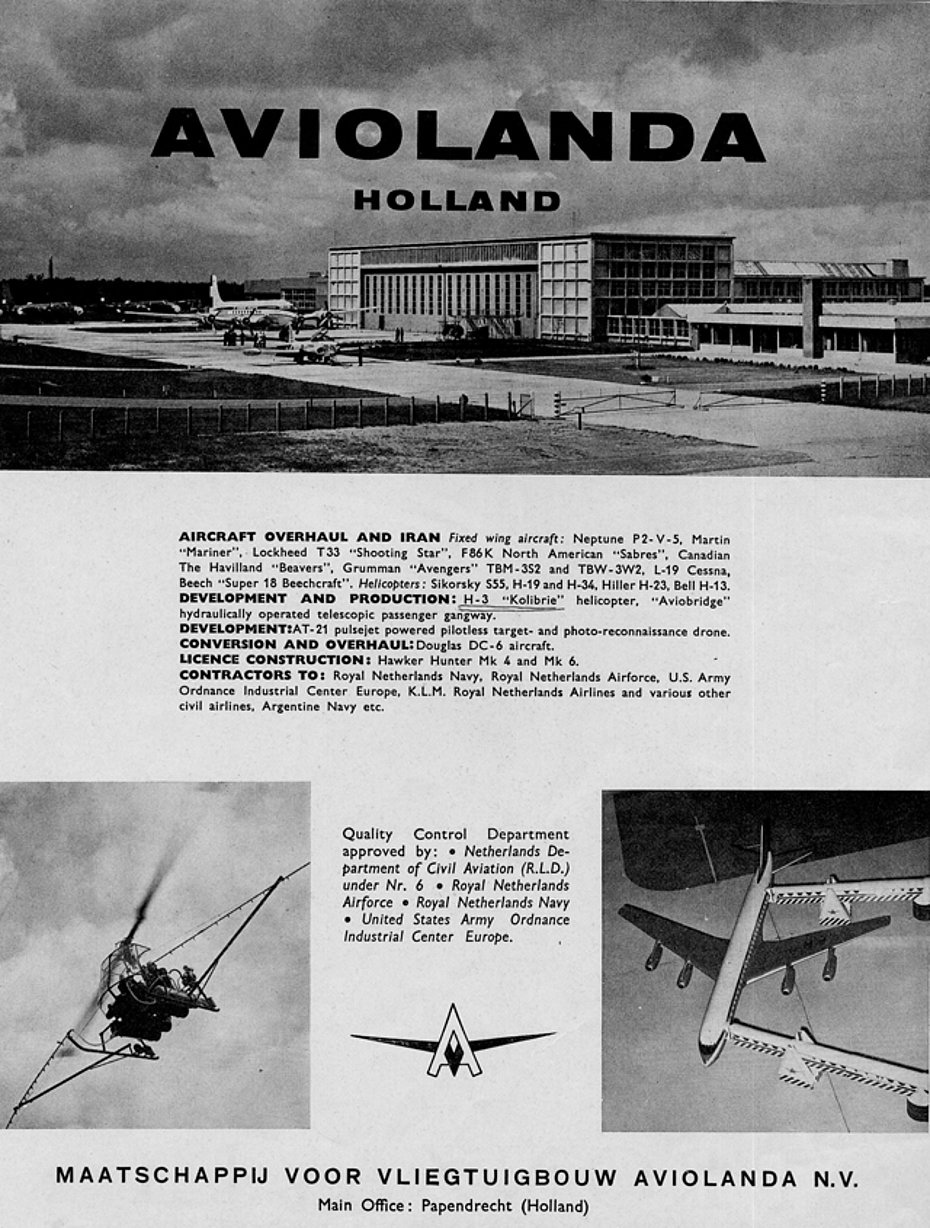
More or less in the same period Jerry Renov thanks to his persuasive abilities and enthusiasm conveinced the N.H.I.’s management to sell him the Kolibrie s/n 3010 which received the Israeli registration 4X-BEE on May 20, 1959.
This model was victim of an emergency landing in the Negev desert caused by an engine failure.
In 1959 the N.H.I. H-3 was again presented at the 23th Internation Paris airshow (12-21 June). On June 19 an announcement was made of an agreement reached with the Swedish company SAAB which got the rights to sell the Kolibries in the Scandinavian countries. A demonstration tour organised in Sweden between 1 and 3 September (the helicopter was flown by René van der Harten) did not lead to any sales.
Aviolanda takes over
On April 14, 1960 Aviolanda (manufacturer of the fuselage) became the sole stockholder on N.H.I. The official announcement was made on May 15. The activities were transferred from Zestienhoven airport to Papendrecht, near Dordrecht, about 15 miles south of Rotterdam. Only engineering personnel was retained. The people in the shop were given an option to become Aviolanda employees, but for various reason most of them did not.
Will A. Kuipers, Dick Biekart and Dik Swart remained the mainstays of the helicopter company and went on the Aviolanda payroll.
In that period the costruction of a second batch of Kolibries was announced. This was the result of the insistence on the part of European Helicopters Ltd which wanted to continue its activity only with an active manufacturer.
After the take-over of Cuba by Fidel Castro the bad relations of Cuba with the USA made impossible for American companies to spray the extensive sugar and rice crops.
European Helicopters Ltd get an extensive contract to spray rice cultivations in the Cuban province of Camaguey. Two Kolibries (PH-ACA and PH-ACB) were therefore sent on the caribbean island. In one month about 1,350 hectares were sprayed (3,335 were treated in total). The best productive hours were in the morning when the air was relatively cool. In the middle of the day the oppressive head affected the lift-off capacity of the helicopter and reduced its productivity. A political change then forced the European operator to stop its activity in Cuba.
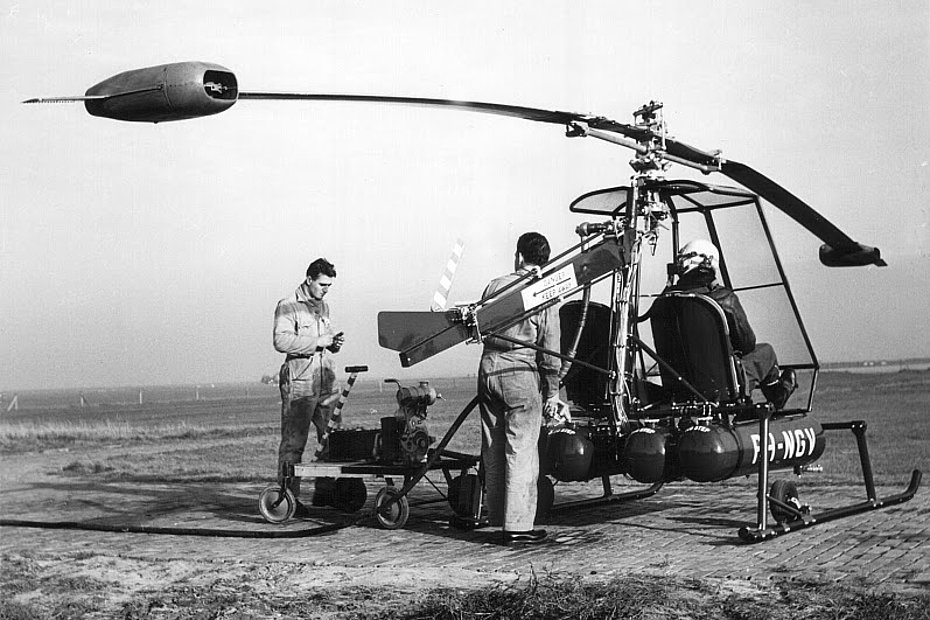
Further development
The last improvement incorporated in the ramjet was the development of the solid, stainless steel, swept-back stabilizing fin that characterize the TJ-5A version. The engine was sturdier and did away with the persistent crack problems in the previous versions. Its most important advantage was that its smaller size and thinner section and also the swept-aft planform, produced much less drag and resulted in a net thrust increase. In addition to incorporating the swept fin, the exhaust opening was made smaller. The combination resulted in a sharply decreased fuel consumption for the same thrust.
This important improvement unfortunately increased considerably the collective control loads. It took an unaccettable amount of phisical effort to raise the collective. To correct this problem the engineers quickly developed a counterweight system for the controls mounted on the hub to offset the undesired effect. Hovewer this solution was not ideal.
During 1960 several efforts were made to make the Kolibries pay by embarking on crop spray operations. N.H.I. turned into an operator itself. One of the operation was an extensive wineyard spraying contract in Austria combined with a demonstration tour. The terrain was for the most part quite hilly and this caused difficulties that were not encountered before in Holland, where the country is for the most part flat with the exception of foothills in the far southeast.
While using a new spraying equipment René van der Harten experienced a violent vibration, apparently the same phenomenon that in 1958 caused the accident which involved the German pilot. The cause was probably an interaction of one of the vibration modes of the fuselage and spray boom with the collective controls.
In other words vertical deflections in the helicopter caused by vibrations of the boom migh have actuated the collective control in such a way that the vibration was aggravated. This would explain the violence of the vibrations since small collective control motions cause very large lift forces in the rotor. According the the managers the problem did not seem important because of the rarity of its occurrence and therefore was not further investigated.
Meantine other modifications were introduced experimentally on the H-3 Kolibrie such as for example conventional control stick or the tubolar tailboom.
Game over
Toward the end of 1960 the decision was made to stop the production of components and put what was finished in storage. Operators using Kolibries had given up for one reason or other. Production of the H-3 Kolibrie ended with three prototypes and eight production machines completed.
Only Jerry Renov in Israel was still active, but he owed the company a large amount of money. The promise of restarting production by manufacturing another batch of ten helicopters had not brought in more customers. Gradually the possibility to continue became more and more remote.
René van der Harten left the company to help organize the KLM helicopter division. Will A. Kuipers, who after the departure of Jan Meijer Drees had taken over as head of the scientific and technical department, emigrated to the USA together with engine specialist Fred de Wilde.
N.H.I. turned into a paper company, with no personnel and no activities.
Parts or all of a total of seven Kolibries found their way to the employ or ownership of Jerry Renov in Israel or companies and people associated with him.
Flying helicopters in Israel with its arid climate presented its own particular problems. Erosion from sand and dust stirred up by the rotor downwash is ever present. Jerry Renov’s experience was that this erosion on occasion caused holes to wear in the inlet of the stainless steel jets, where material thickness here was 1/8 inch. This type of erosion was fairly easily rapairable. A greater problem was the erosion of the rotor blades.
Knowing that production of blades had been discontinued at Fokker, Jerry Renov went to Netherlands in 1963 and obtained s/n 3006 PH-YMP and s/n 3008 PH-ACE as well as usable parts of s/n 3003 PH-NGT and s/n 3004 PH-ACA used in Cuba and Austria.
Renov continued to use its Kolibries for many years. The last known Kolibrie apparently used for spraying operations was seen in Tel Aviv in May 1984.
Epilogue
From a technical point of view the obtaining of an airworthiness type certificate (in some European nations) was undoubtedly a brilliant achievement for the small Dutch team, but as had already happened with other models built experimentally especially in the United States after World War II and in the 1950s, the effort was not reciprocated with the hoped-for commercial success.
The undoubted technical simplicity of this and other models built earlier (the first was the Mc Donnell XH-20 Little Henry which appeared in 1947) was countered by problems of another kind.
Reliability, low maintenance, robustness and safety were certainly very attractive features to which, however, were offset by the fuel consumption, which, taking into account the limited payload of the small helicopter, was monstrous to say the least: during spray operations, the two TJ-5 burned around 500 litres (132 USG) per hour! Consumption was about 400-450 litres per hour (106-119 USG) during cruise flight. Consequently, the range was also limited. Another problem that was far from negligible was the noise produced by the reactors: during the endurance tests, complaints were received from people who lived five kilometres away!
Will A. Kuipers in his account states that consumption could certainly have been reduced, but by then the fate of the N.H.I. H-3 Kolibrie was already sealed due to other problems of a completely different nature, such as the unhealthy personal relationships between the various managers.
Also appearing on the market in that period there were similarly performing helicopters such as the SO 1221 Djinn, a direct competitor to the NHI H-3 Kolibrie, which enjoyed a fair amount of commercial success and was produced in 179 units.
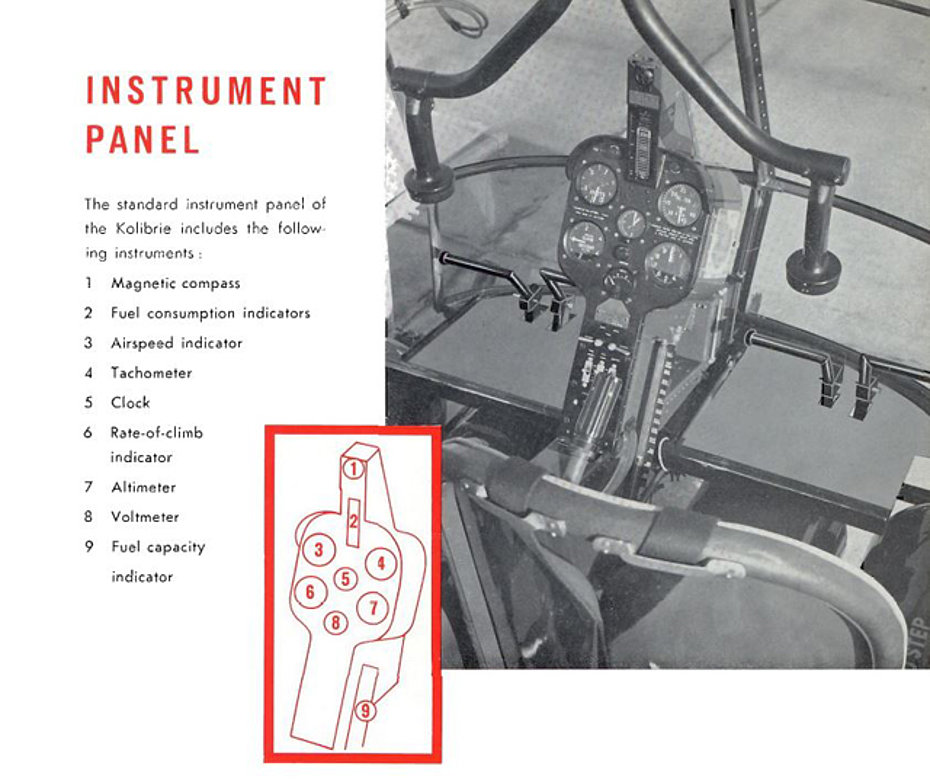
Technical description
The N.H.I. H-3 Kolibrie is a light two seat open-frame helicopter equipped with a two-bladed rotor driven by a pair of ramjets one at the tip of each rotor blade. The single blade tail rotor is driven by the motion of the main rotor.
The occupant’s seats are protected only by a Plexiglas front panel.
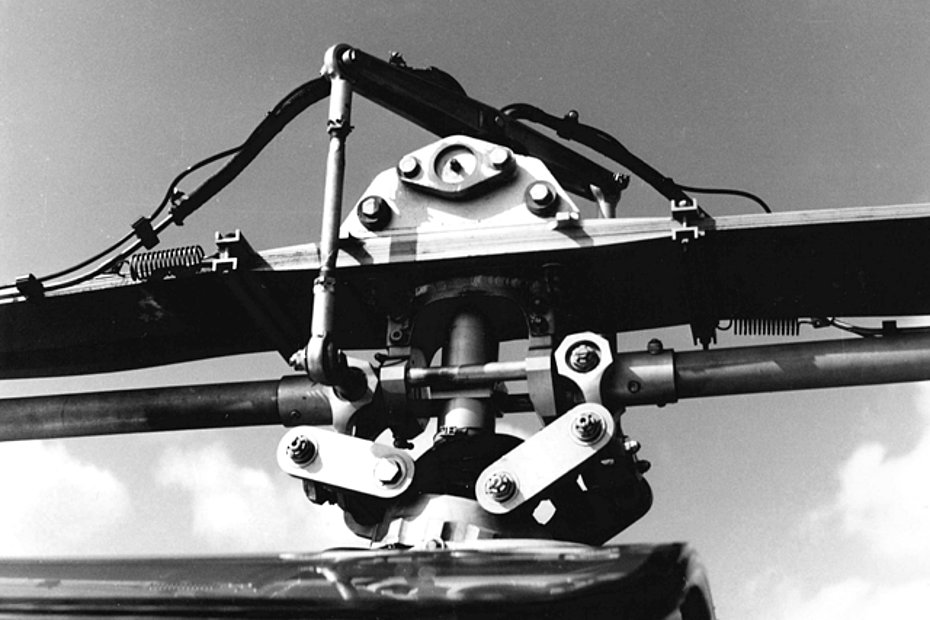
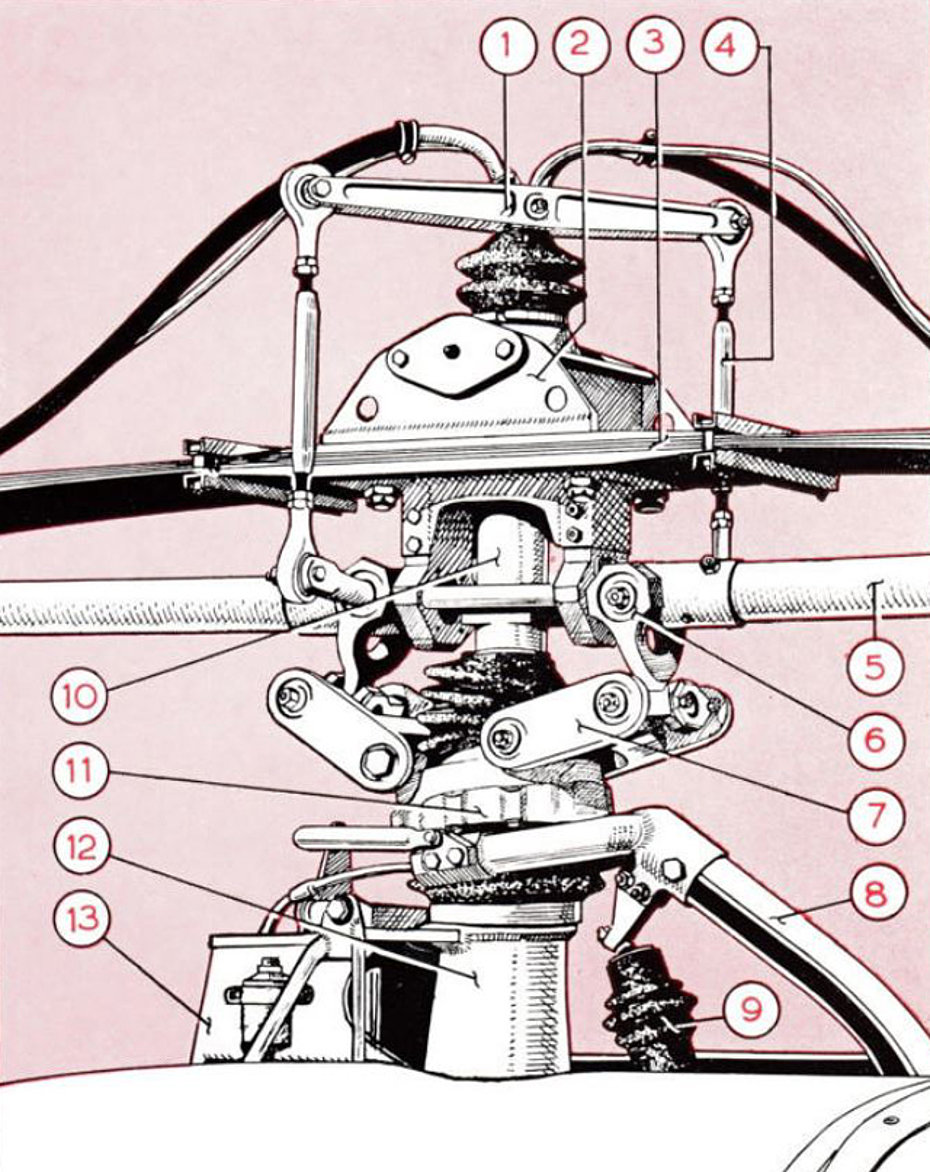
1 collective pitch control yoke
2 rotor hub
3 blade retention straps
4 push-pull rod
5 blade control tube
6 cyclic pitch control yoke
7 scissors link
8 cyclic pitch control stick
9 cyclic pitch control trim
10 main rotor shaft
11 swash plate
12 main rotor shaft bearing housing
13 rotor mast
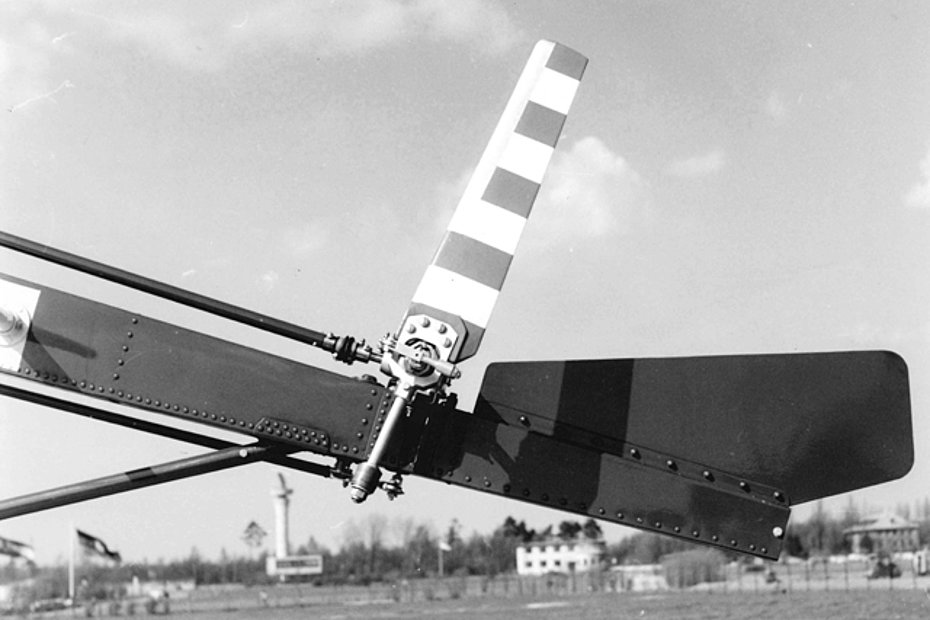
Rotor system
Two-bladed “see-saw” main rotor. The main rotor blades were made up of nose and trailing edge extrusion with two spars and two skin sections, all Redux-bonded and reinforced with doublers at the roots. Packet of leaf springs attaches each blades to the hub. Blade profile modified NACA 0012, blade chord 25 cm (9.8 in).
Normal operating range 370-420 rpm. Area of each rotor blade 1.093 m2 (11.76 sq. ft.). Total main disc area 79.2 m2 (852.2 sq ft).
The main blades had to be inspected every 150 hours, while every 600 hours they had to be replaced.
Single blade tail rotor of laminated wood construction.
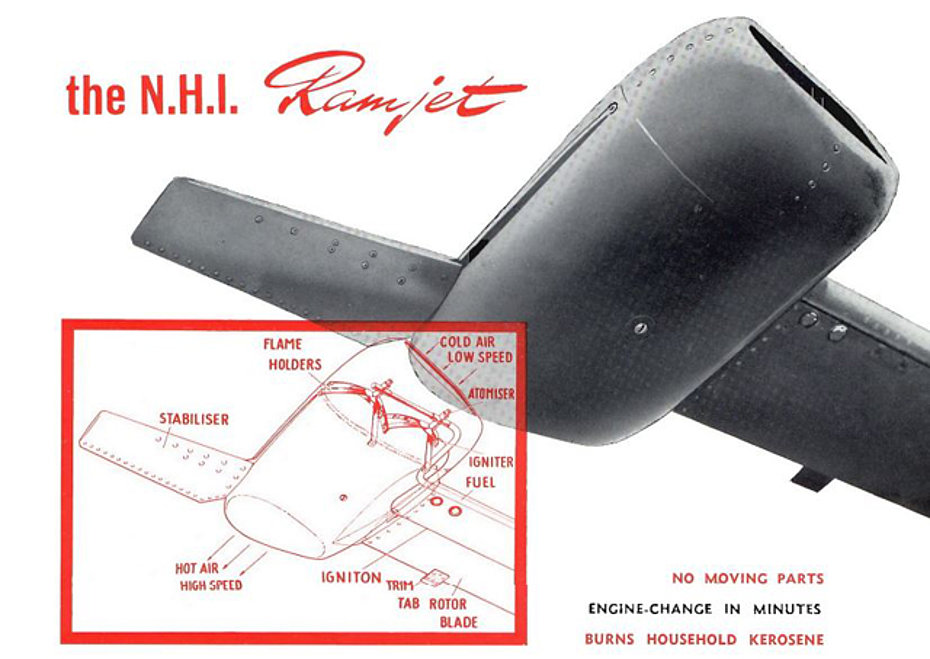
Fuselage
2024 aluminium alloy (in older systems of terminology this alloy was named 24ST Duralumin 24ST) box structure.
Landing gear
Metal skids with two ground handling wheels. No shock-absorbers. Skid track 1.90 m (6ft 2.5 in).
The ramjets
Each consists of a profiled crankcase equipped with fuel injectors, deflectors and a low-voltage ignition system. Each develops a power of 40/60 kW/hp and weights 9.5 kg (21 lbs).
Each ramjet was attached to the blade by means of two bolts. The fuel lines and ignition circuits connected automatically. When the blades turned, centrifugal force alone ensured the flow of fuel along the blade and then to the ramjet. The latter could be replaced in only few minutes.
In case of one engine failure altitude could not be maintained and the pilot was forced to land but with a largely decreased rate of descent. A light vibration occurred in that case because of the asymmetric power, but apparently this had no serious effect on fuselage and crew. An feature of the independent fuel system was the possibility of a separate check of the engines before take-off.
According to the documentation gathered, at 150 hours of operation pairs of engines were x-ray tested and fitted with new burners, matched on a test stand at N.H.I. and re-installed. The estimated minimum service life was 300 hours. After 600 hours it was necessary to replace the ramjets.
The ramjet could run at any given fuel, like kerosene, gasoline and petroleum.
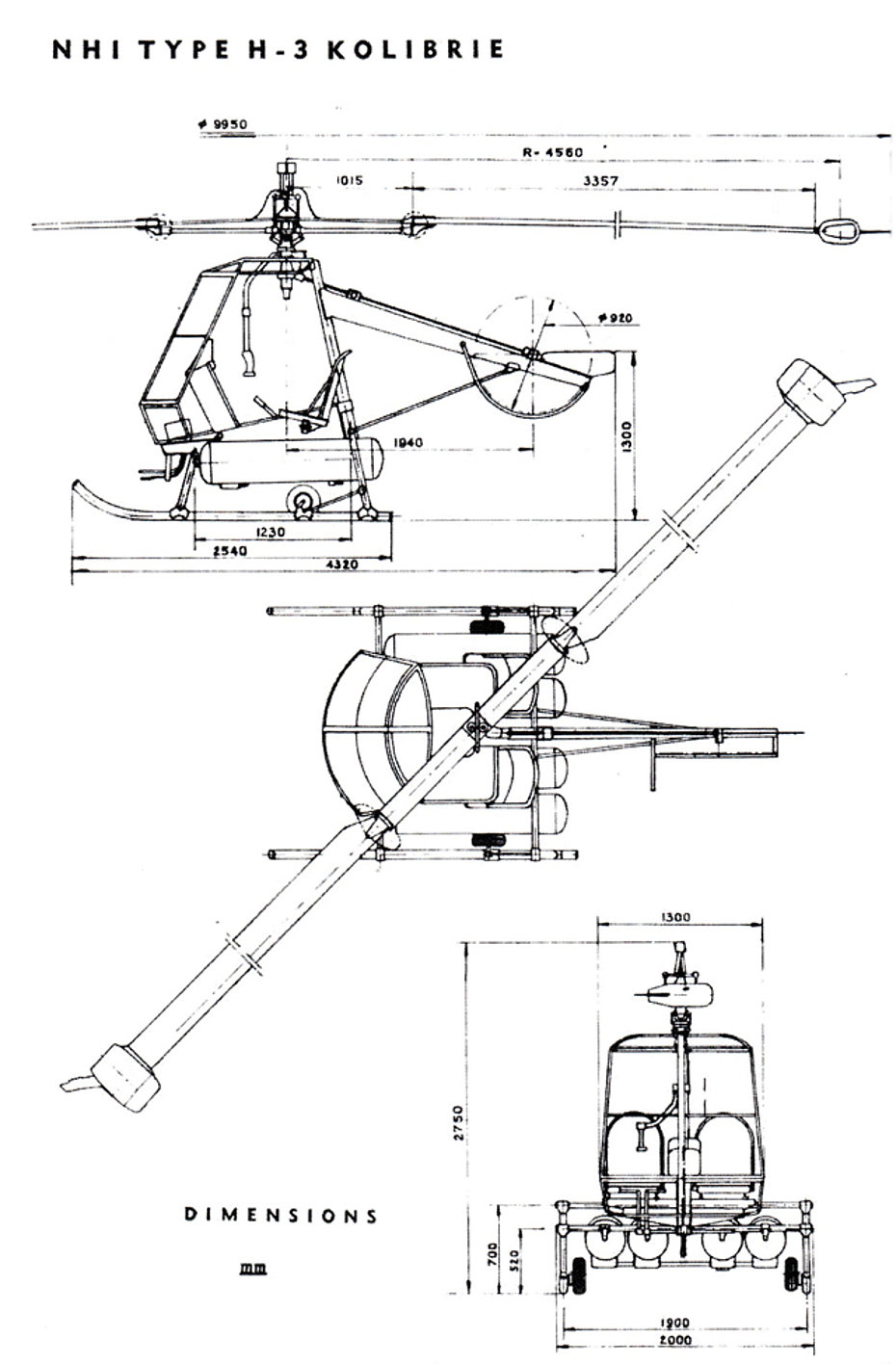
Ignition and operation
Before the ramjets could be ignited, the rotor had to be launched at a speed of 120 rpm by means of the Puch two-stroke engine connected through a chain to the transmission that drives the tail rotor and the main rotor.
The latter could be mounted directly on the helicopter or used as an auxiliary source of power (in this case it was mounted on a trolley), which allowed a slight weight saving in favour of the payload.
Before starting the motor, the fuel taps were closed and the controls set in the neutral position. The throttle twist grip mounted on the end of the collective pitch was then fully opened.
At a speed of 120 rpm the fuel taps were opened while the ignition circuit was closed via a button mounted on the cyclic pitch lever.
The mixture of air and fuel was then ignited in the stator via a low-voltage 'Smitsvonk' spark plug. As the rotor turned, the fuel supply was ensured by centrifugal force. Initially, however, the fuel had to be pumped up to the top of the rotor. To prevent it from dripping into the reactors before ignition, the taps remained closed.
Ignition took place easily under all temperature and humidity conditions. At 150 rpm the starter motor was disconnected. At the same time, the ignition and fuel pump could be switched off. The portable battery replaced the on-board battery in order to save weight. When the ramjet was running, the throttle was first fully closed and then gradually opened and the speed increased to 420 rpm.
Before take-off, the pilot checked the operation of the two ramjets separately by closing the two fuel supply switches.
Dimensions
The drawing shows the main dimensions:
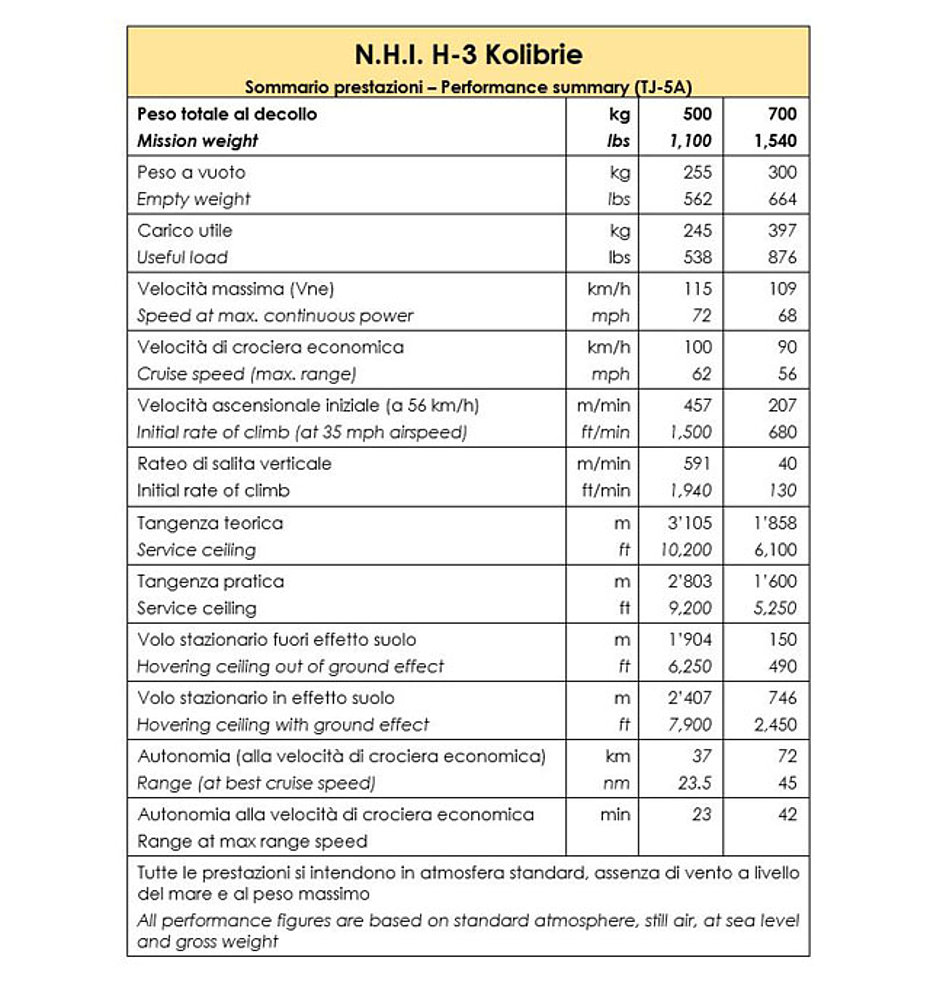
Fuel
Four cylindrical fuel tanks mounted below body on landing-gear cross struts. Total fuel capacity 440 litres (116 USG).
The average fuel consumption was about 460 litres/hour (122 USG/h)
Accomodation
Normally two seats. Alternatively with one seat the H-3 Kolibrie could be adapted to carry two stretchers.
Weights
Empty weight 255 kg (562 lbs), maximum take-off weight 650 kg (1,420 lbs). With a limited fuel reserve, the helicopter could lift a slung load of up to 300 kg.
Performance
The table shows the main performance of the N.H.I. H-3 Kolibrie:
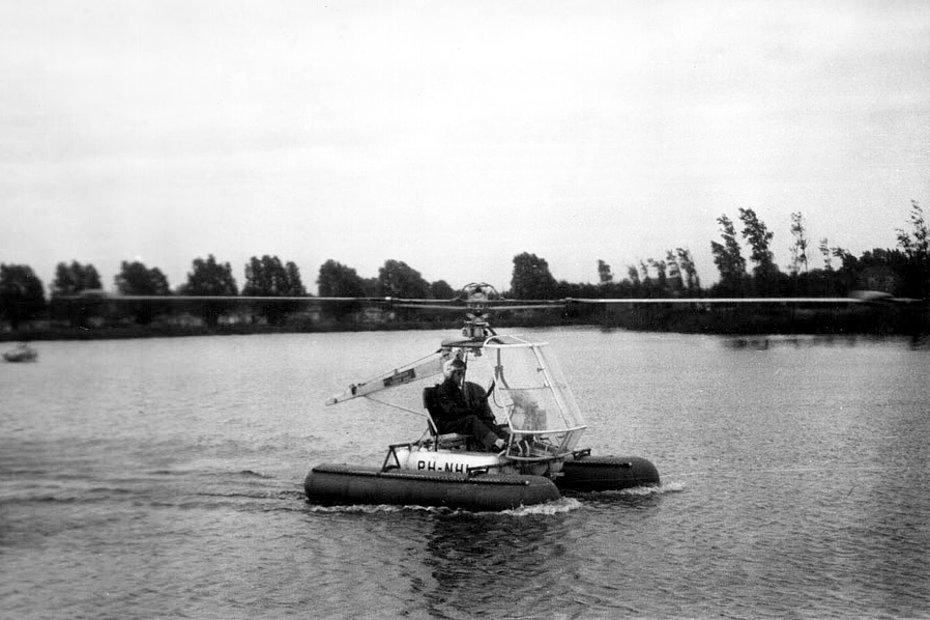
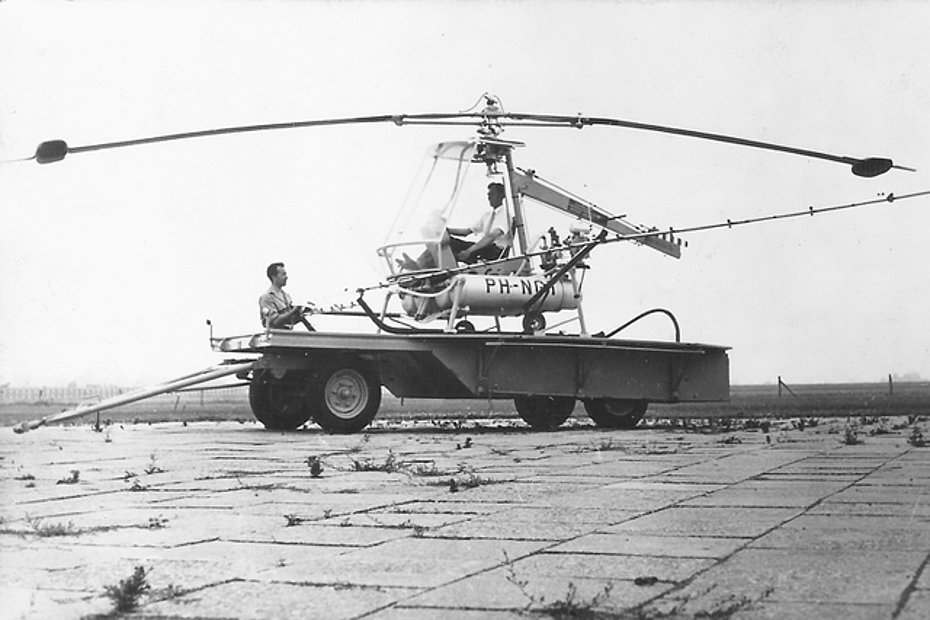
Accessories
A series of optional equipment were developed to be used on the N.H.I. H-3 Kolibrie. The list included: spray kitr (15.00 meters width spray booms collapsible for road transportation), dusting equipment, seeding equipment, two casualty litters, cargo hook, load-container, pontoons for amphibian operations, mud-ski’s, dual controls, enclosed cockpit, fire-fighting equipment, intercom, radio set.
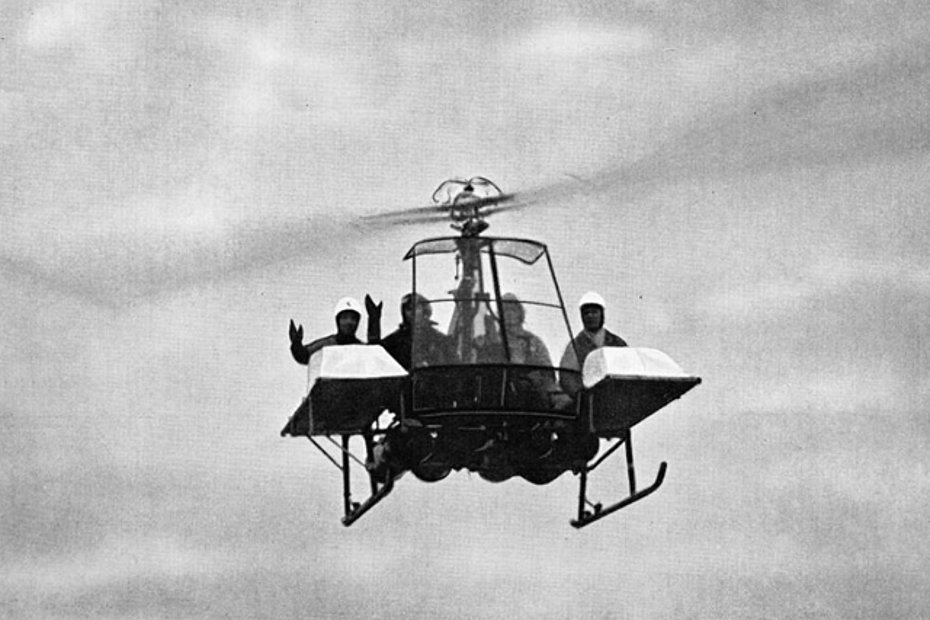
Civil employ
The few N.H.I. H-3 Kolibries manufactured were mainly used to spray crops, but it could also be used for aerial photography, surveillance flights, flight school, and the urgent transportation of wounded people.
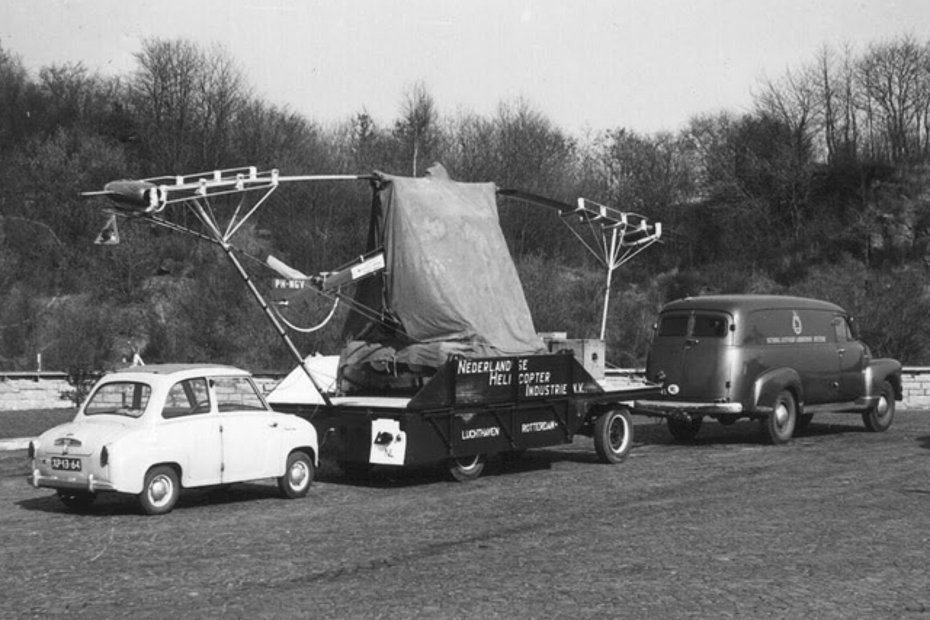
The N.H.I. H-3 Kolibrie in Switzerland
The small Dutch two-seater made a single appearance in Switzerland in March 1959.
The reasons that prompted the Dutch team to come arrive in Switzerland lay in the fact that some of the potential customers wanted to know the performance of the helicopter at high altitude. Such requests came from Turkey, Lebanon and El Salvador where the helicopter was to be used to spray cultures. One particular request came from New Zealand, where it was to be used to bring down to the valley the venison.
On-going efforts to obtain certification in the United States, through the Paris bureau of the FAA, necessitated to show proof that the Kolibrie complied with one of the requirements of their Part 6, namely that at its gross weight the helicopter could hover at better than 1,220 metres (4’000 ft) altitude. This latter was difficult to do, unless to go at an airport at that, or a similar altitude.
Test flights had shown that somewhere above 1,830 metres (6’000 ft) the engines had the tendency to flame-out. Mixture became gradually reacher finally approaching the rich flame-out limit.
René confessed that flying at high altitudes was an uncomfortable experience for him and that coming down at a relatively high rate of descent, he was worried about his judgment of altitude remaining for a safe landing.
This experience started a flurry of activity in developing re-light capability in the jets which were normally lit at a relatively low speed during start-up, and the best sport for the igniter had been found for that condition. Now a sheltered spot needed to be be found that would work at full speed. Two igniter designs were developed, one at N.L.L. and another at N.H.I.
An additional difficulty was encountered in that the fuel-air mixture was harder to ignite the longer the time lapse from flame-out.
For a while all the metal parts inside the jet, which was build out of stainless steel, would retain their high temperature. Fuel flowing though was still pre-heated and so more easily ignited. After a longer period the flowing fuel had a cooling effect on the metal, so reducing the amount of pre-heat and it would get harder to get the mixture ignited. In the absence of a fool-proof and reliable method of re-ignition, René suggested to study the performance of the helicopter at a high altitude airfield. This would lessen the risks and also allow to do tests at high gross weights.
An effort to find a suitable high altitude airfield close by, in West Germany, through the people at Dornier, turned up nothing. Therefore the team decided to test the Kolibrie at Samedan airport, close to the internationally known resort of St. Moritz.
At an elevation of 1,707 metres (5,600 ft), Samedan it is the second highest airliner airport in Europe (with Courchevel in France being the highest). Samedan for the chronicle is also considered one of the most challenging airports in the world because of its difficult topography and winds, and because of the thinness of the air at its altitude.
The location was perfect in view of obtaining the data to meet the qualification requirements of the US Civil Airworthiness Regulation.
Arrangement were made for a crew consisting of a Kolibrie mechanic and a N.L.L. instrumentation technician, to make the trip in the N.H.I. van pulling the trailer with the Kolibrie. They were escorted by Fred de Wilde, engine specialist, and Will A. Kuipers. René van der Harten and Tjabbe Hoekstra arrived in Switzerland separately by air. The convoy arrived in Switzerland on March 17, 1959.
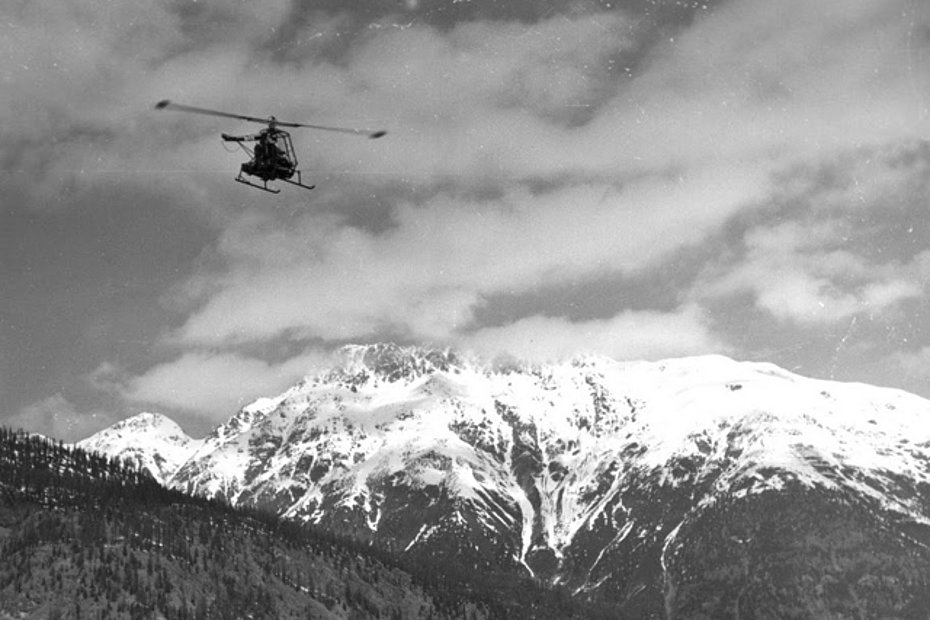
Aided by ideal weather conditions even if cloudy much of the time the team started the flight test program the successive day. During the flights it was apparent that the ramjets were losing much unburned fuel in the engine’s exhaust, a clear signal that the fuel mixture was too rich.
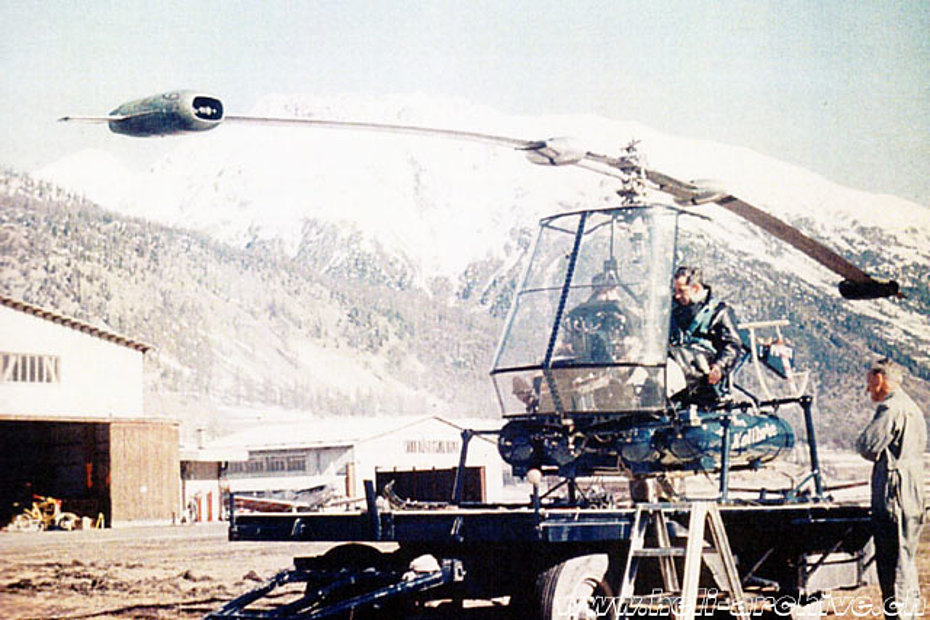
As a result flying at high gross weight caused to be close to rich flame-out all the time and almost all the landings were one-engine flame-out landings. Because of the effects of altitude on autorotation and landing flare performance of the Kolibrie were a lot trickier than in Holland. Thanks to René’s piloting mastery none of the landings resulted in damage to the helicopter.
It was clear from this tests that at that stage of the development the helicopter was not particularly suited for flying at high altitude. Despite this during one of the flights it reached an altitude of 2,960 meters (9,720 feet). The flight tests with PH-NGV were conducted in the period between 18-24 March. According to Rene’s logbook altogether the helicopter logged 9h10’ of flight.
After the return to Holland in the interest of safety an automatic mixture device was developed. That was the first and the last time the Dutch helicopter made its apparition in Switzerland.
Video
Here are some videos showing the N.H.I. H-3 Kolibrie in action. In this video filmed in 1970 Jerry Renov sprays chemical products along the border between Israel and Giordania. In this second video the N.H.I. H-3 Kolibrie G-APRZ piloted by René van der Harten sprays cultures in England. In this video it is possible to see the workshop of the N.H.I., one of the test stand and a flight demonstation that shows the manoeuvrability of the helicopter.
Acknowledgements
I want to express my gratitude to the Helicopter Museum in Buckeburg for kindly providing a part of the photographs published along with the article.

